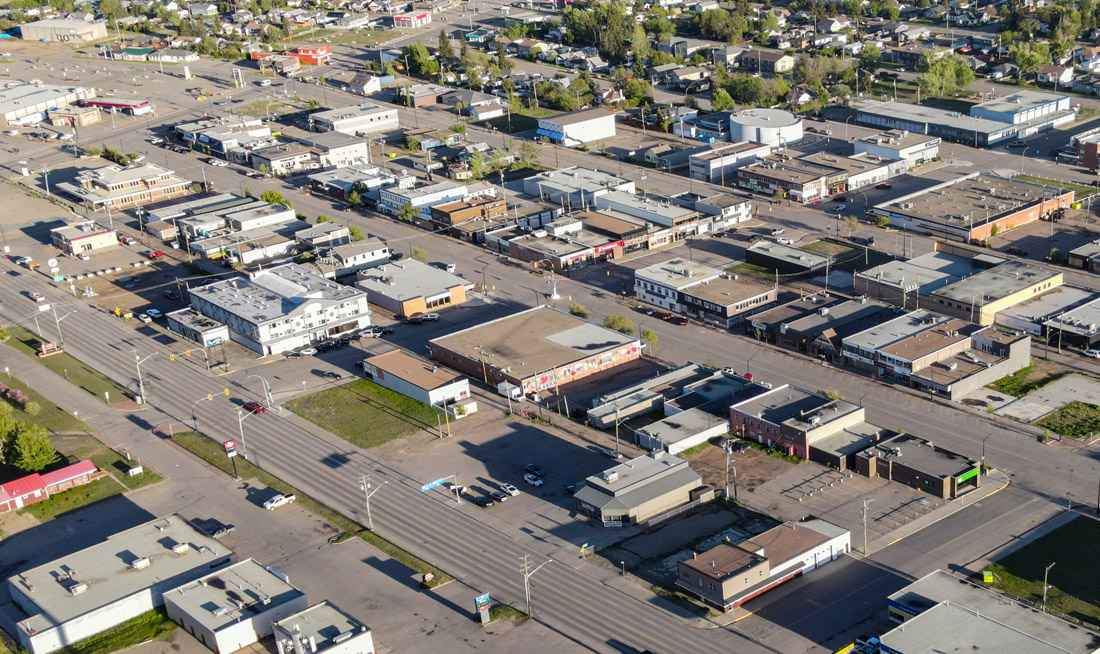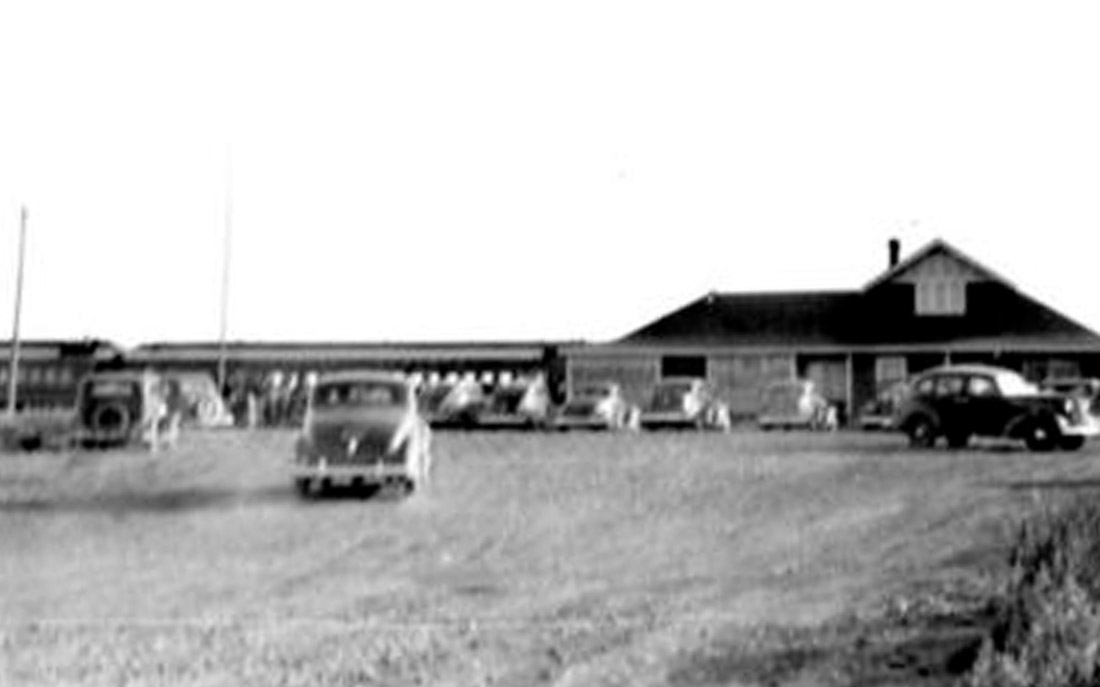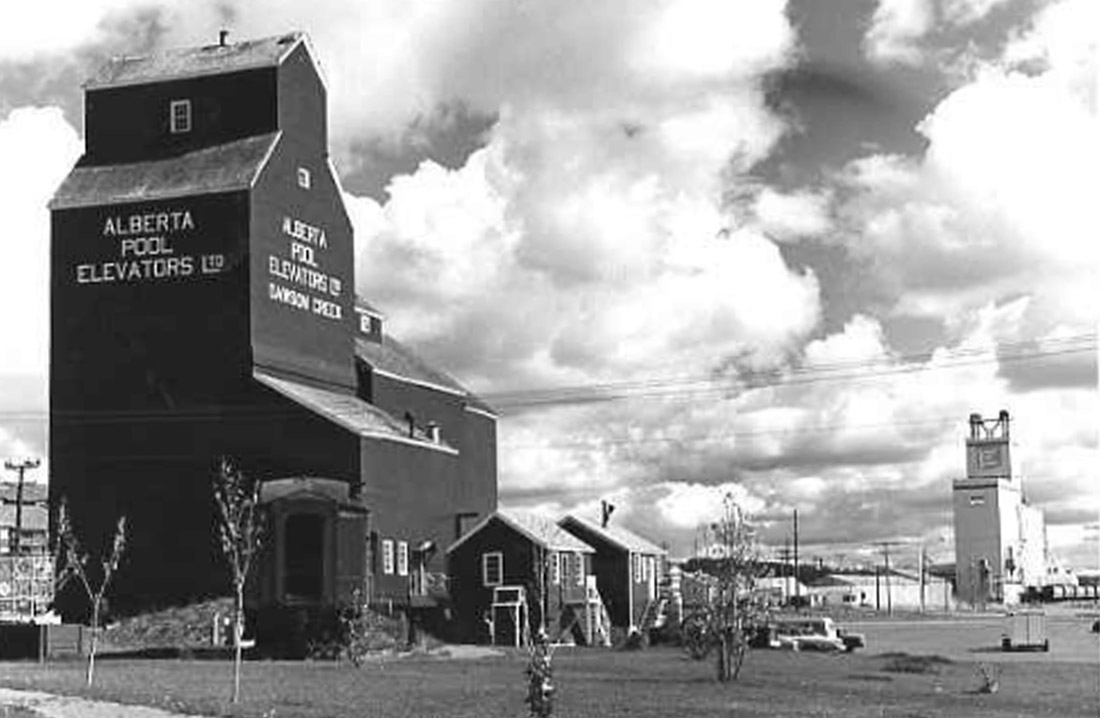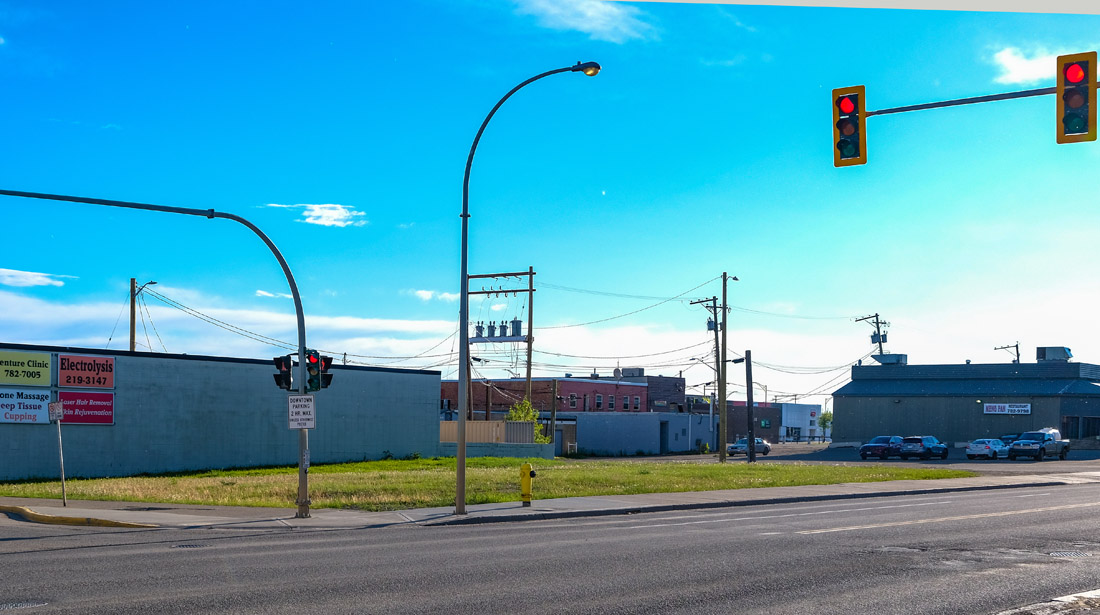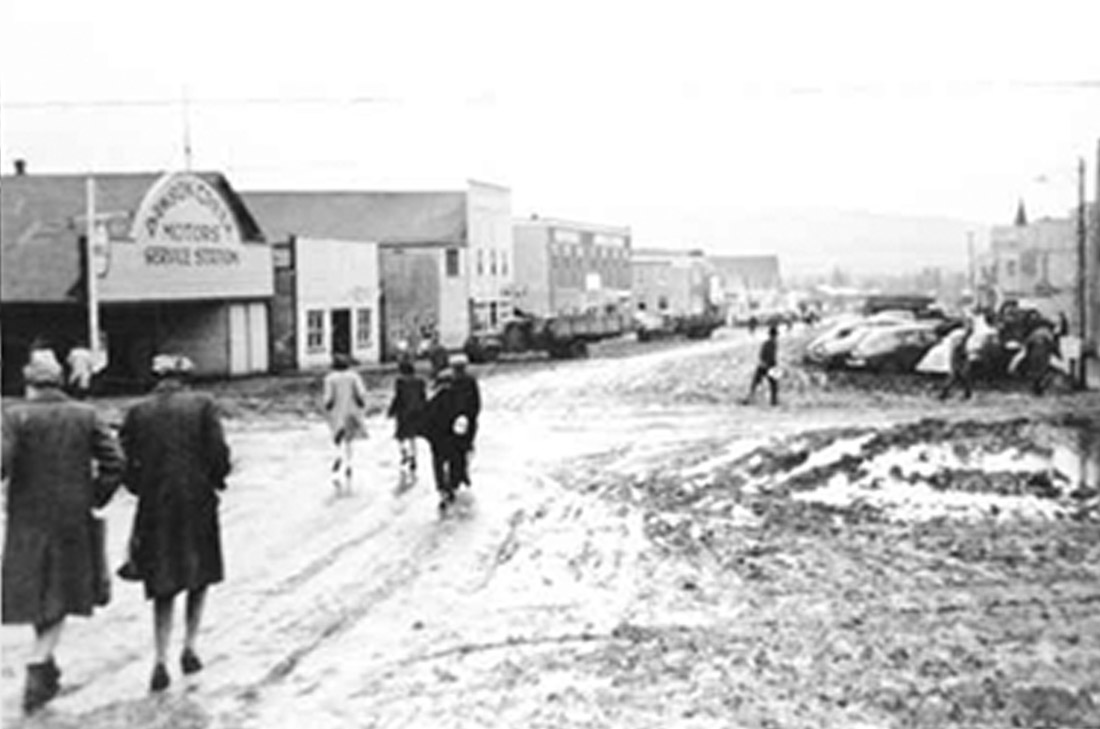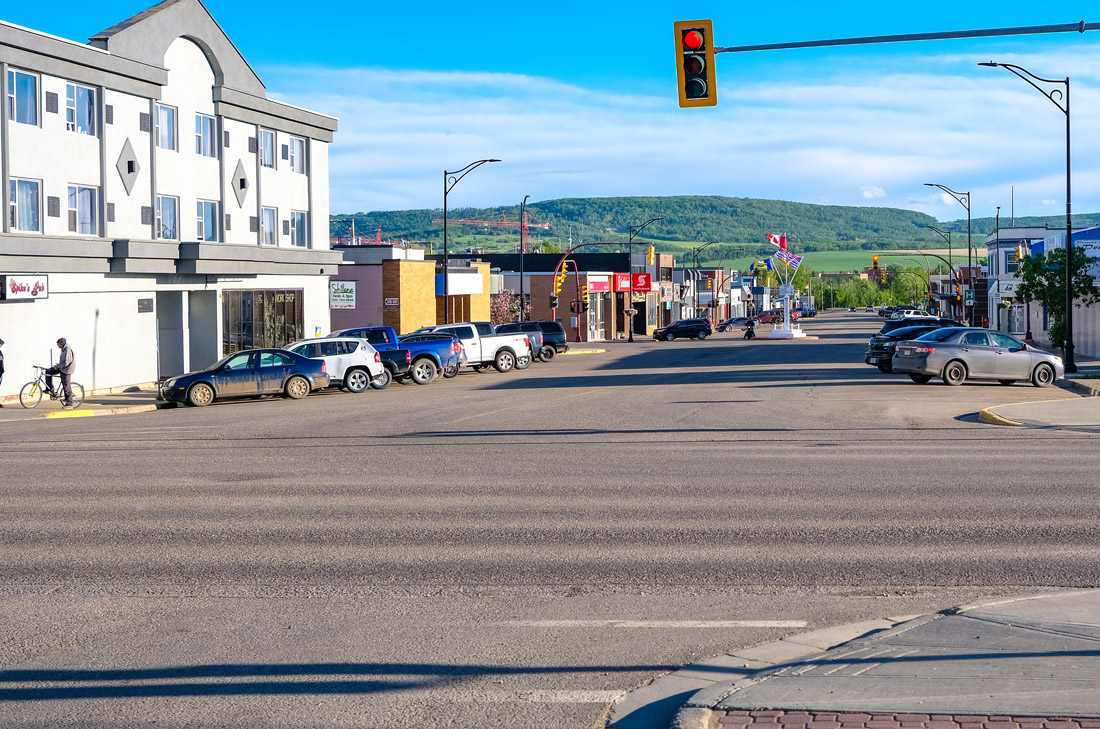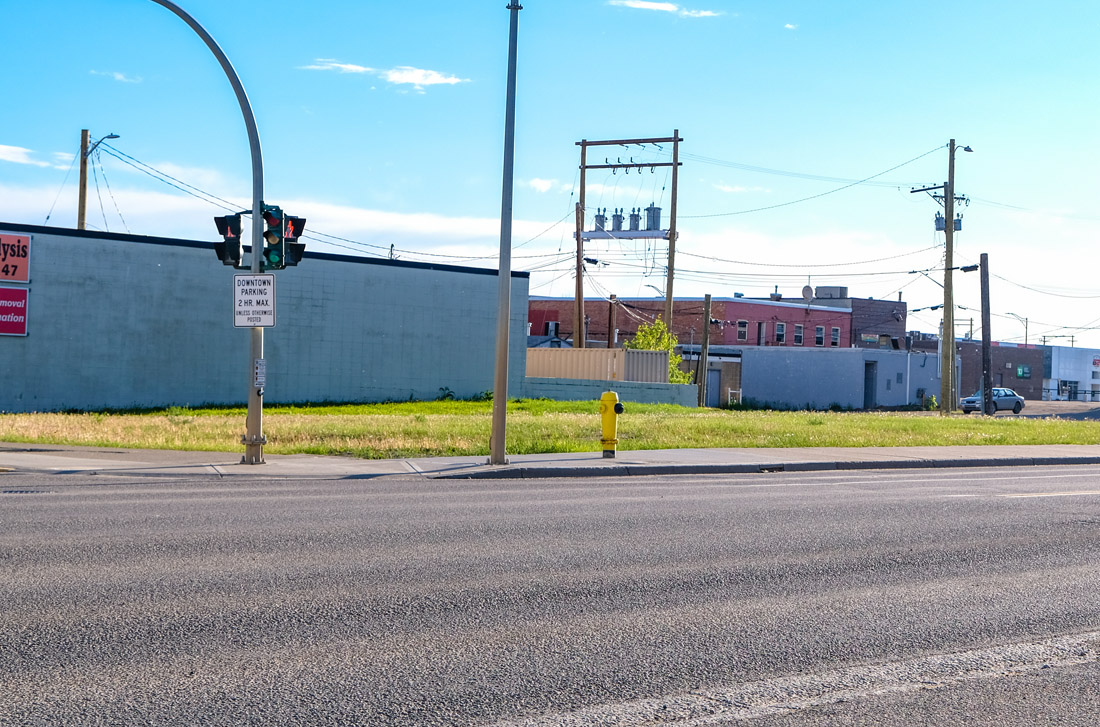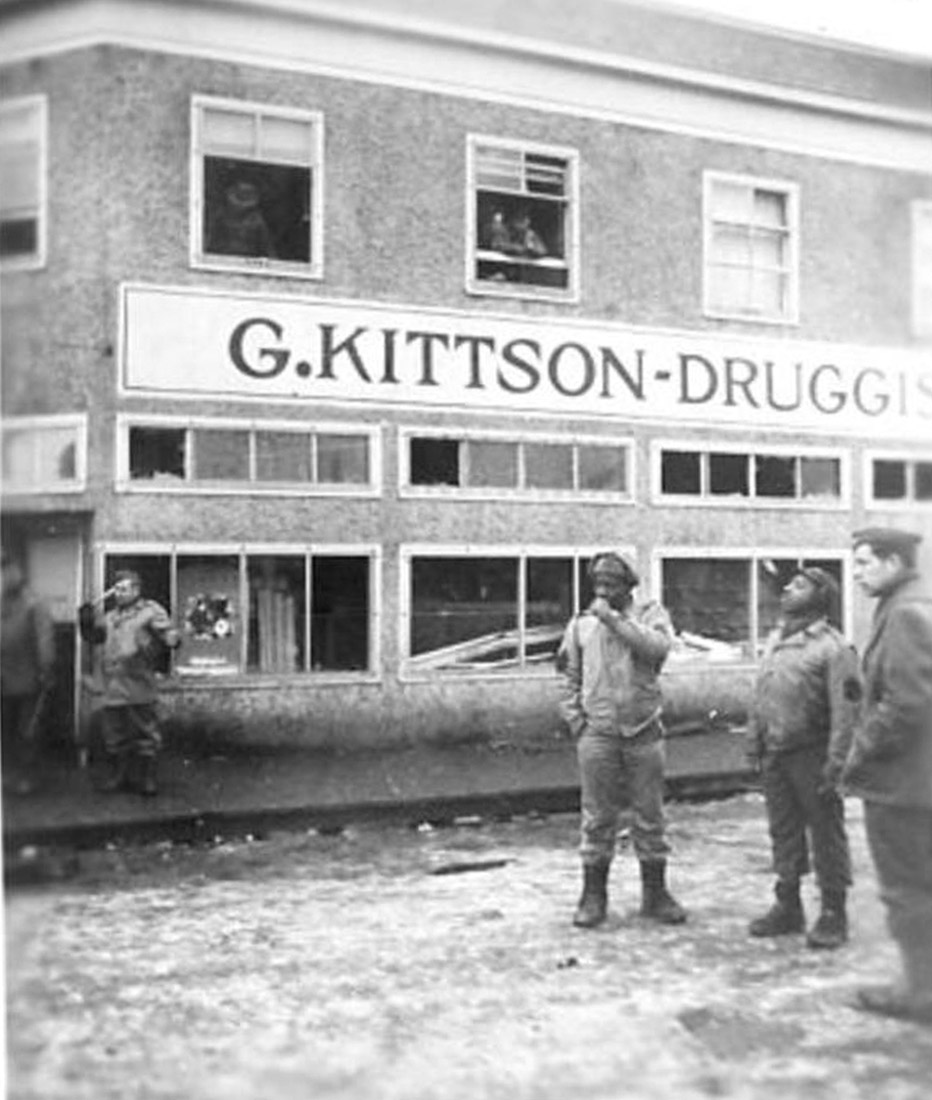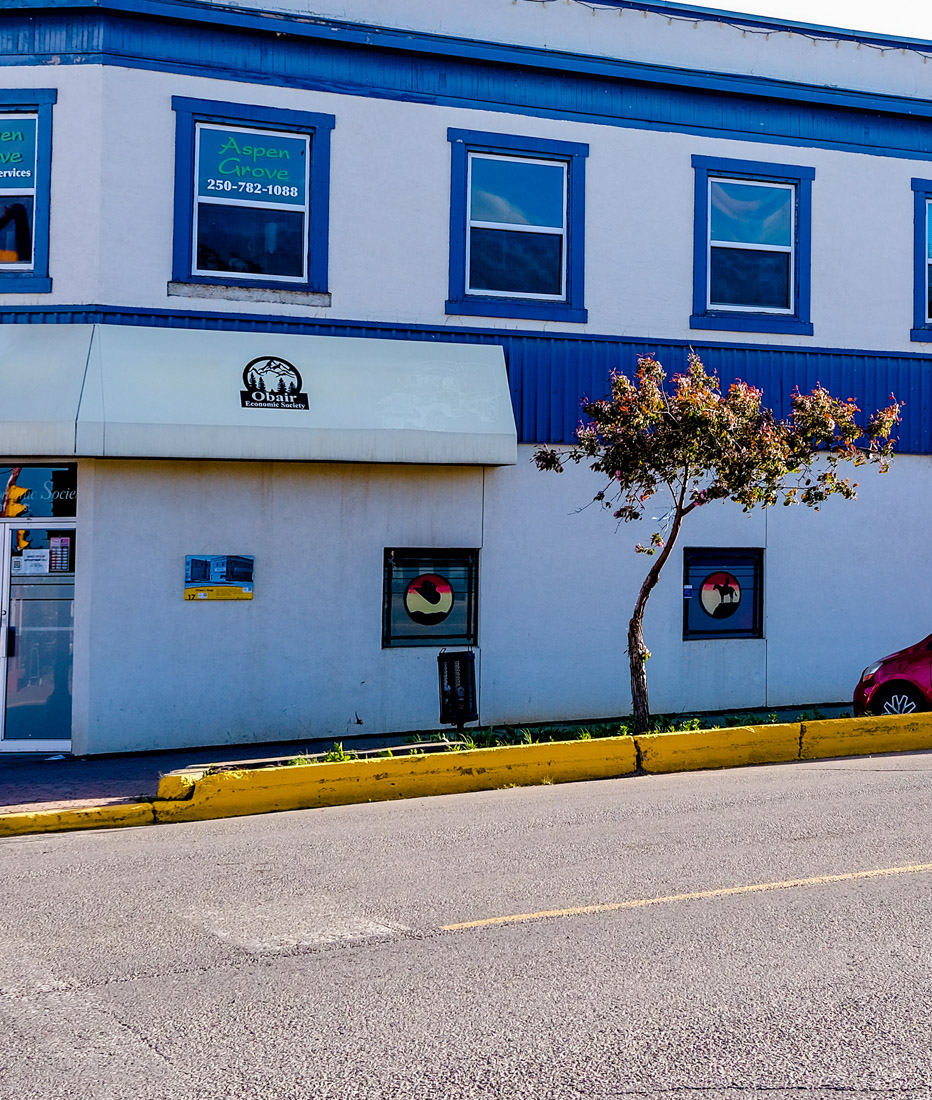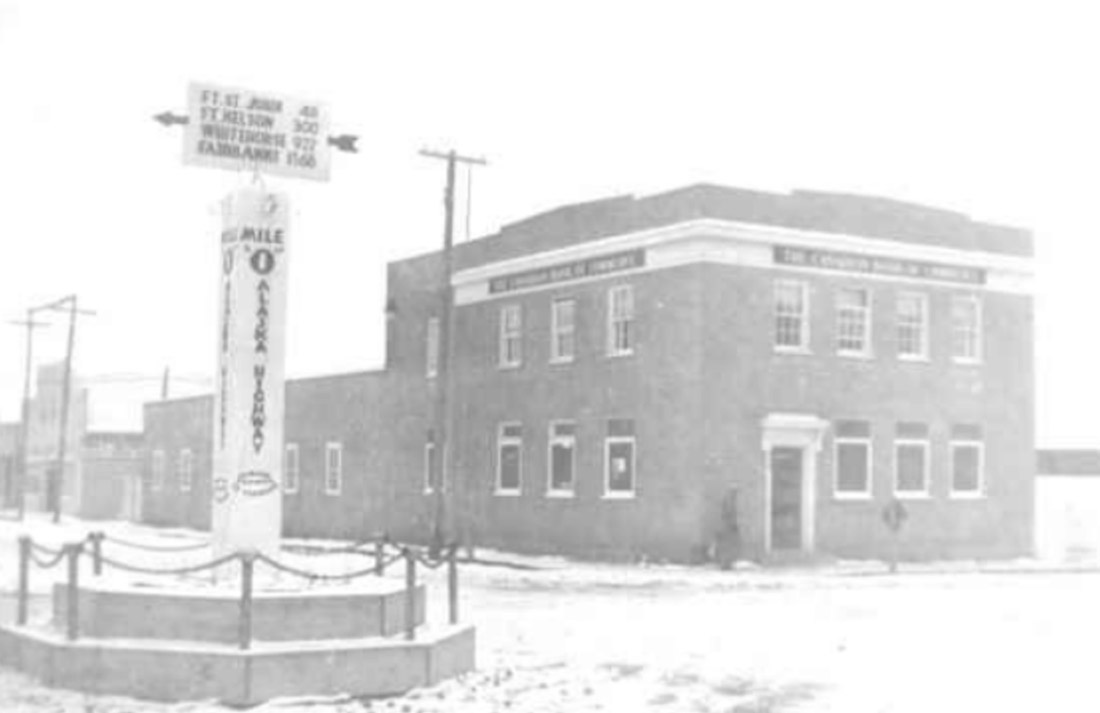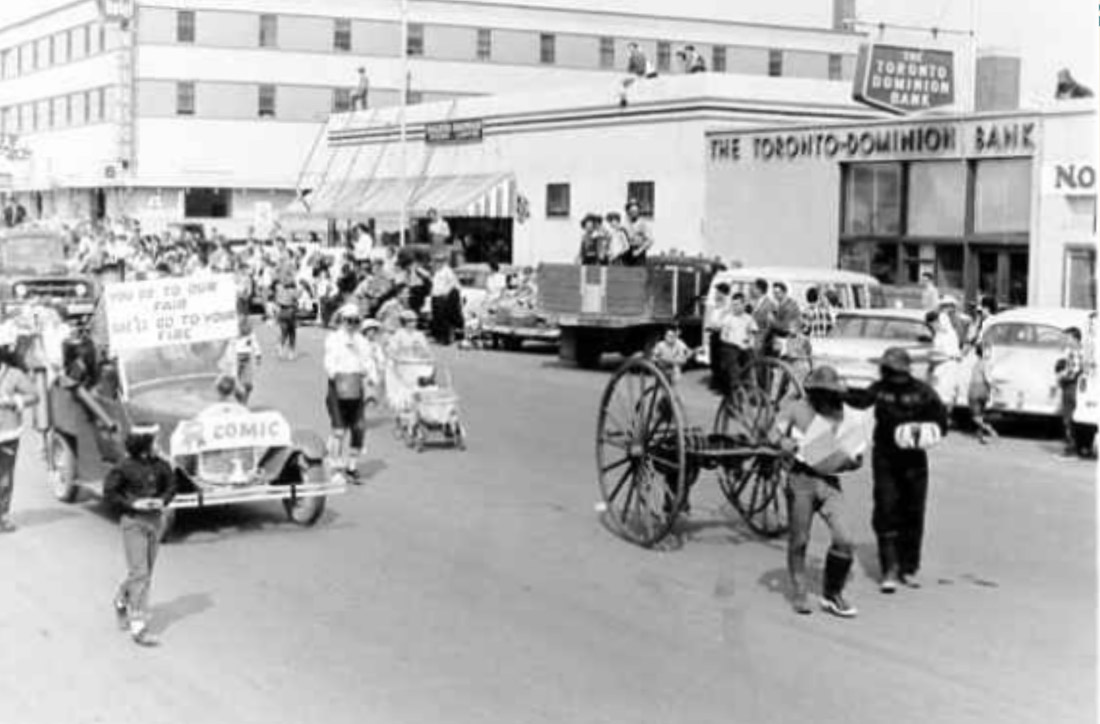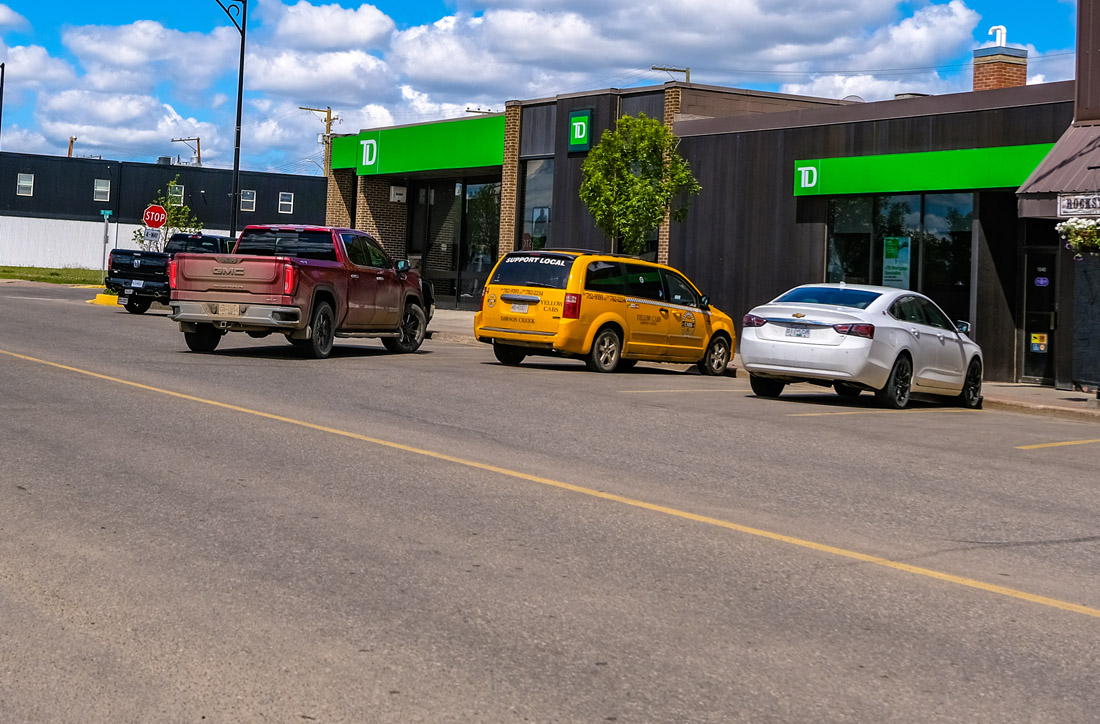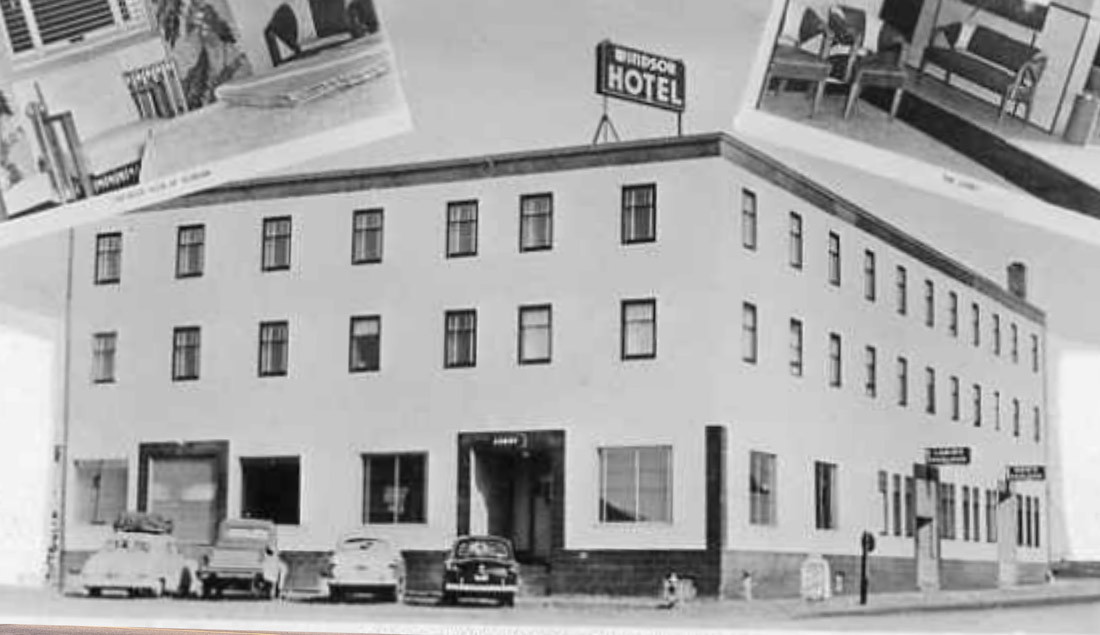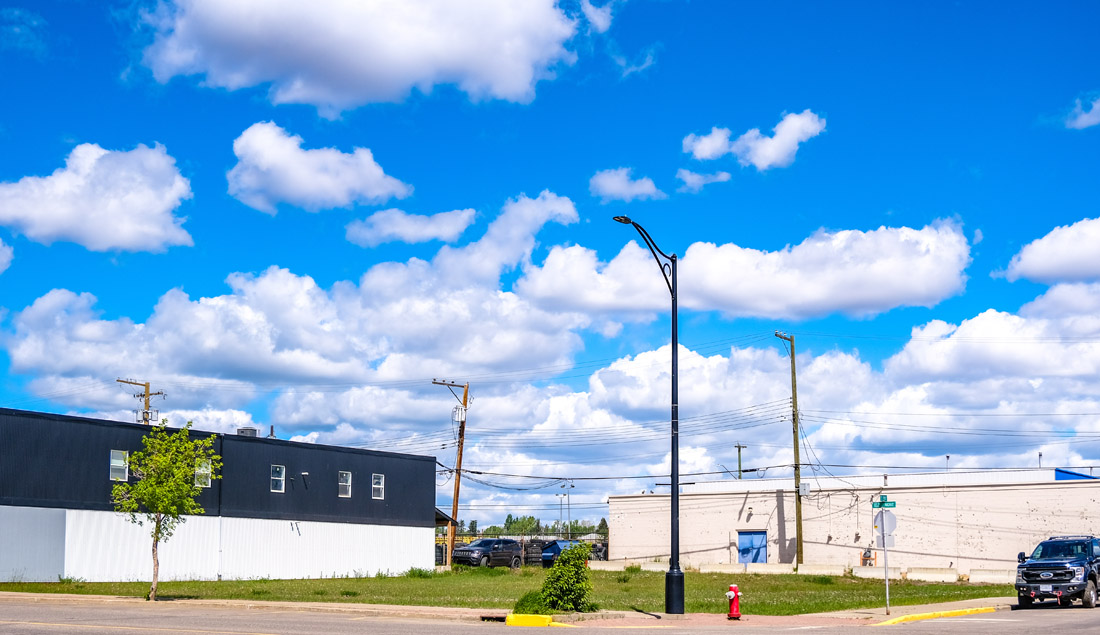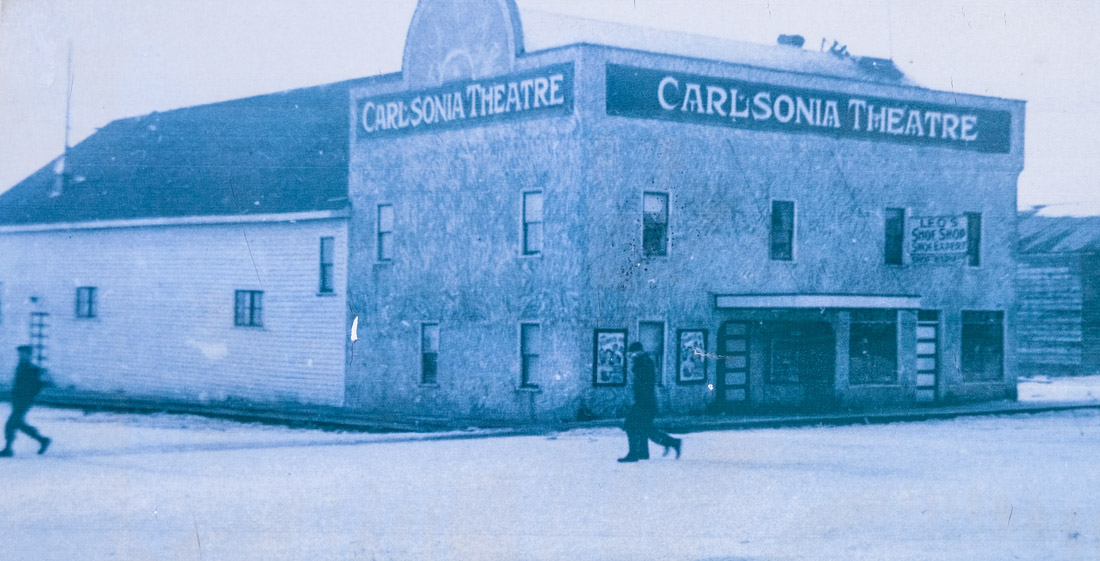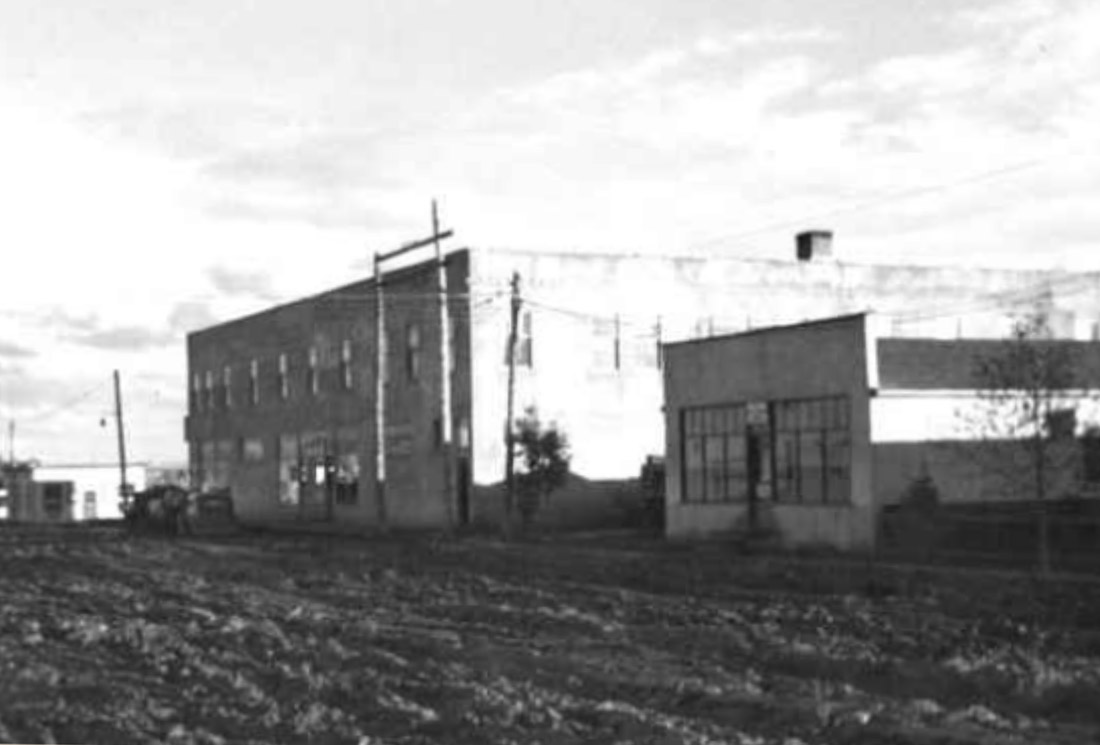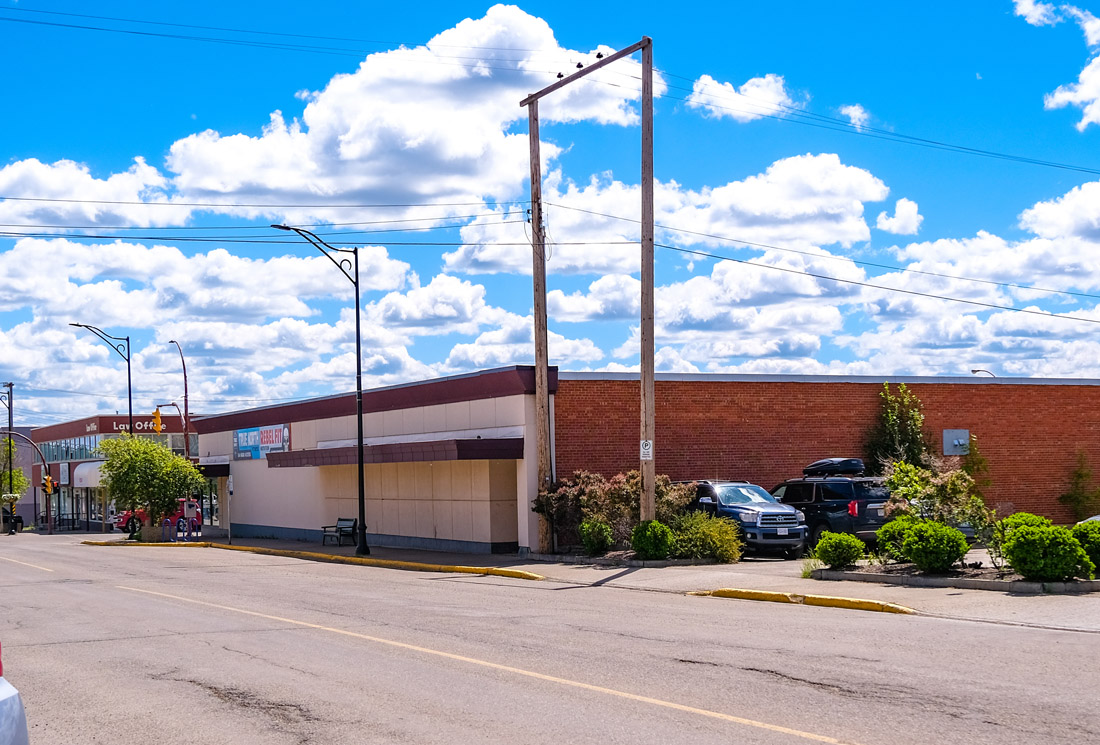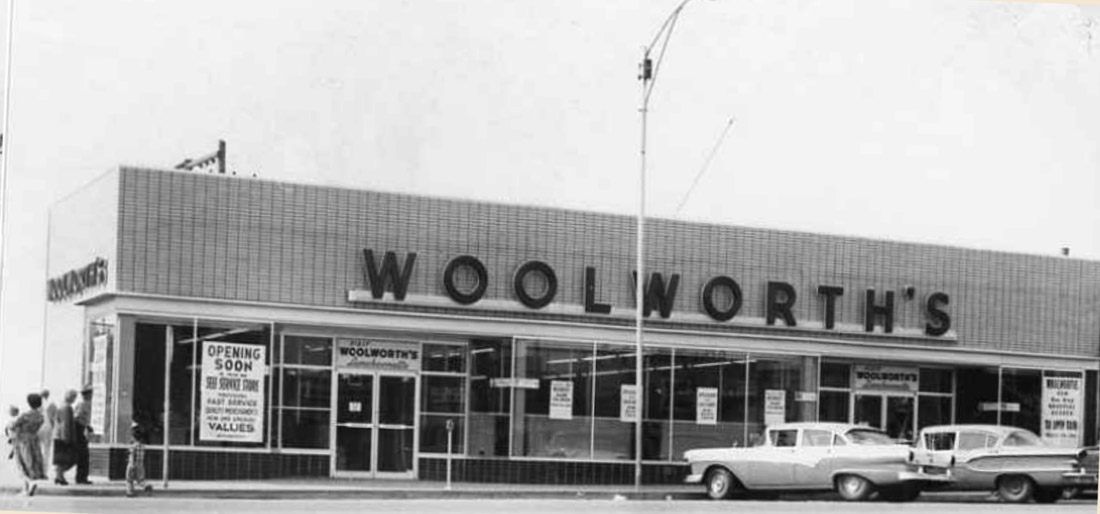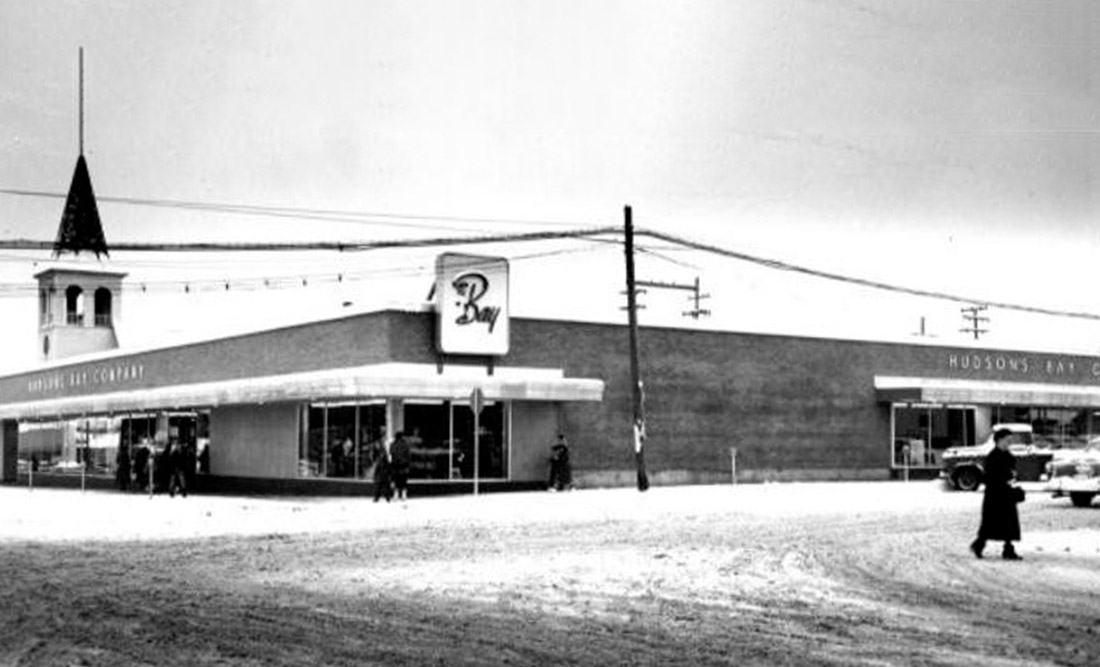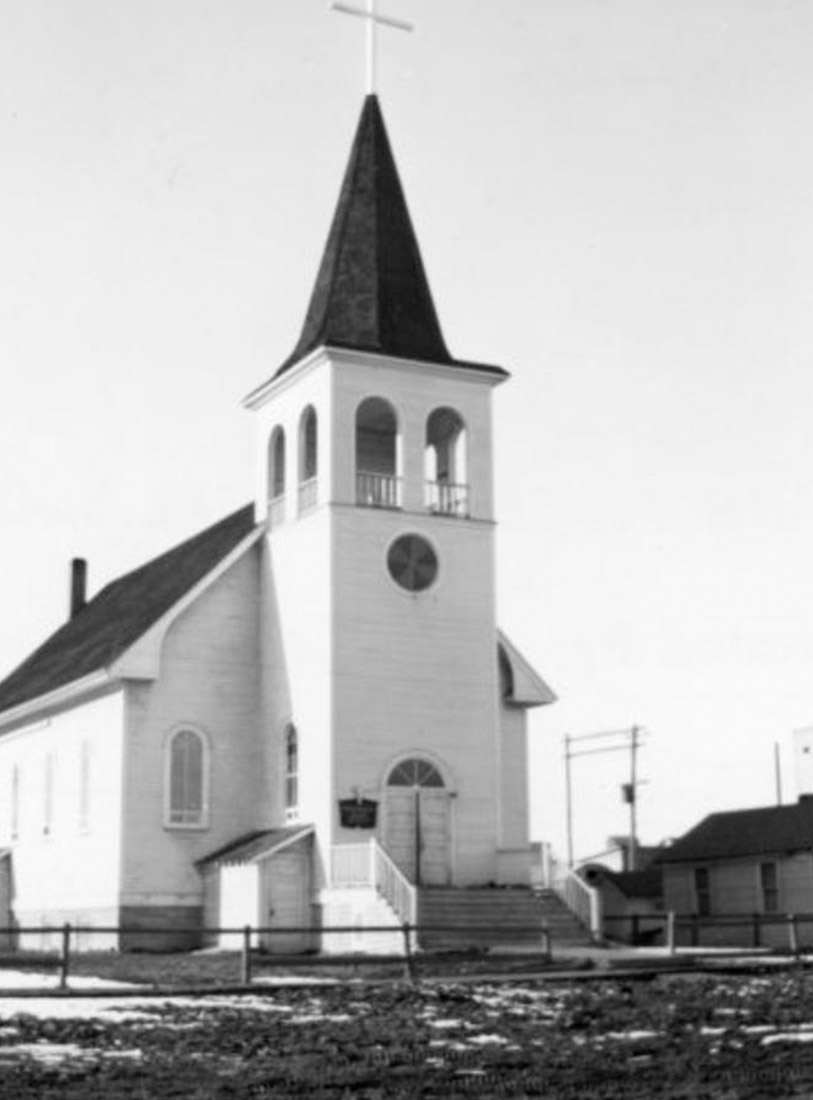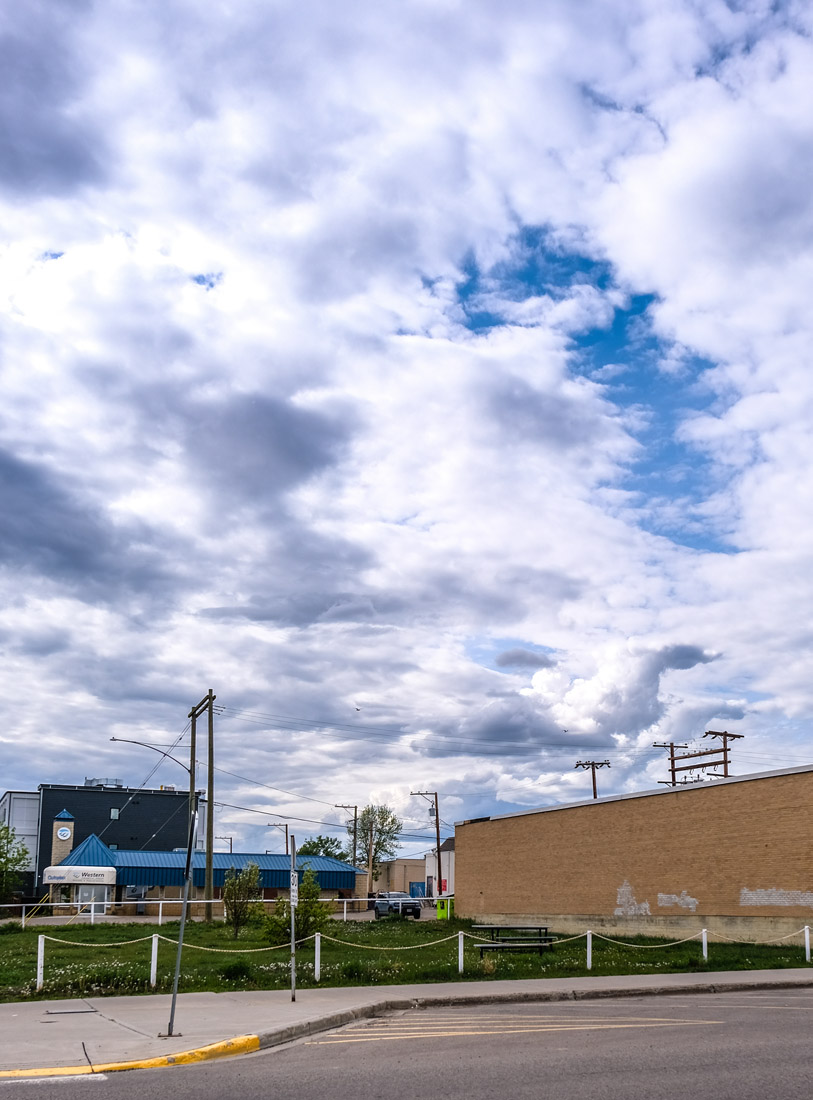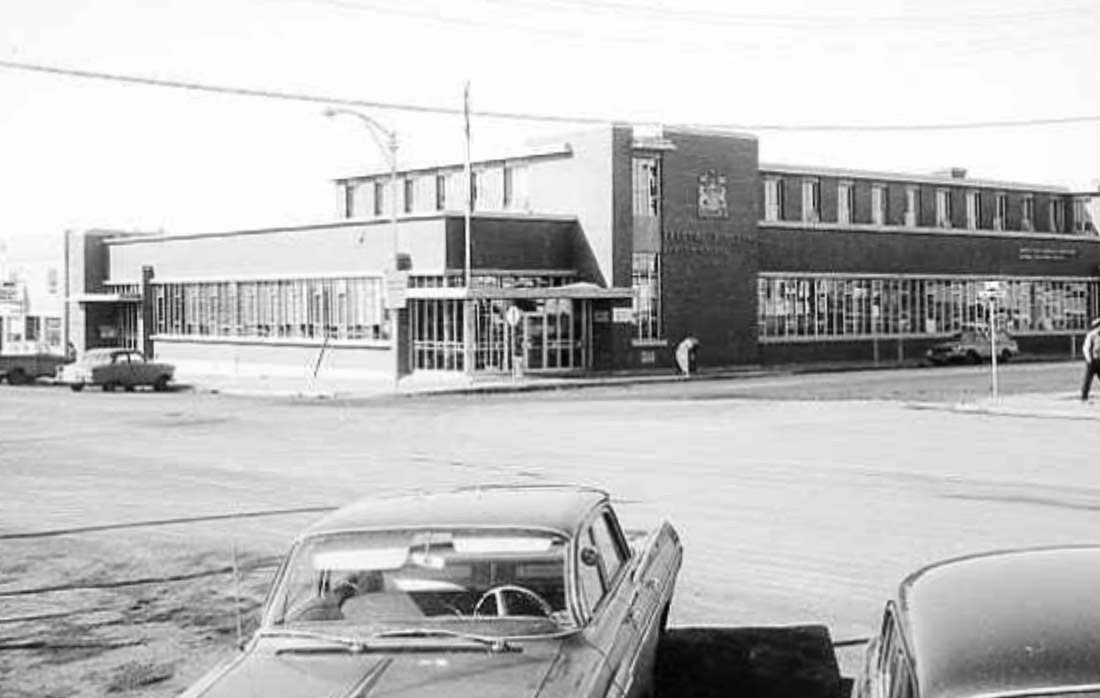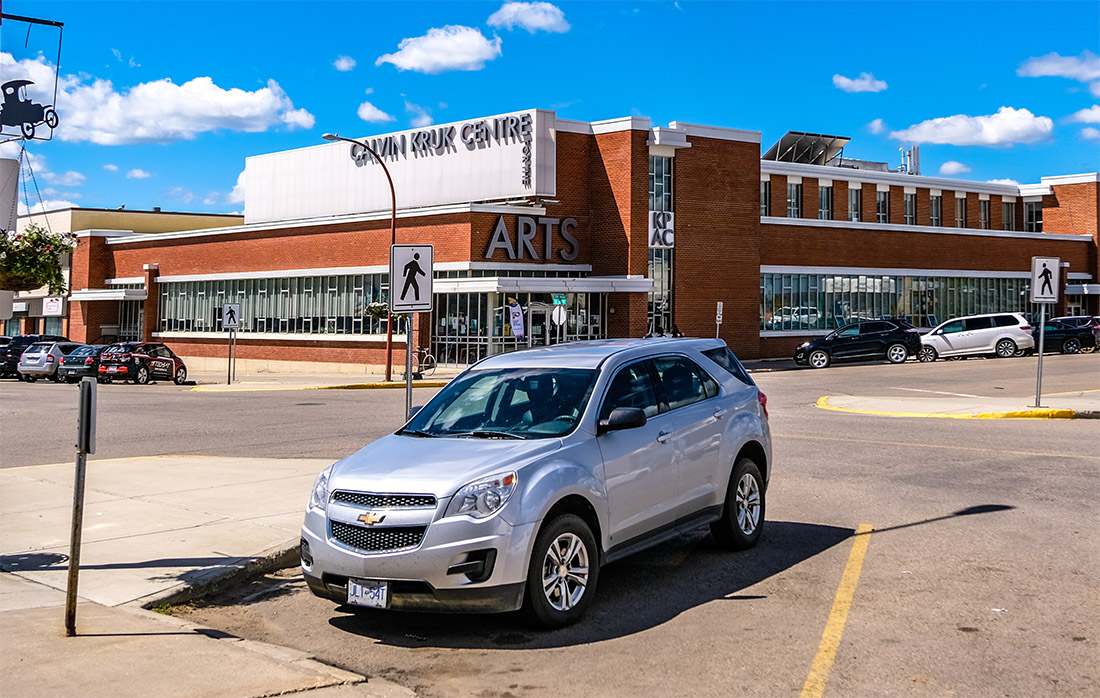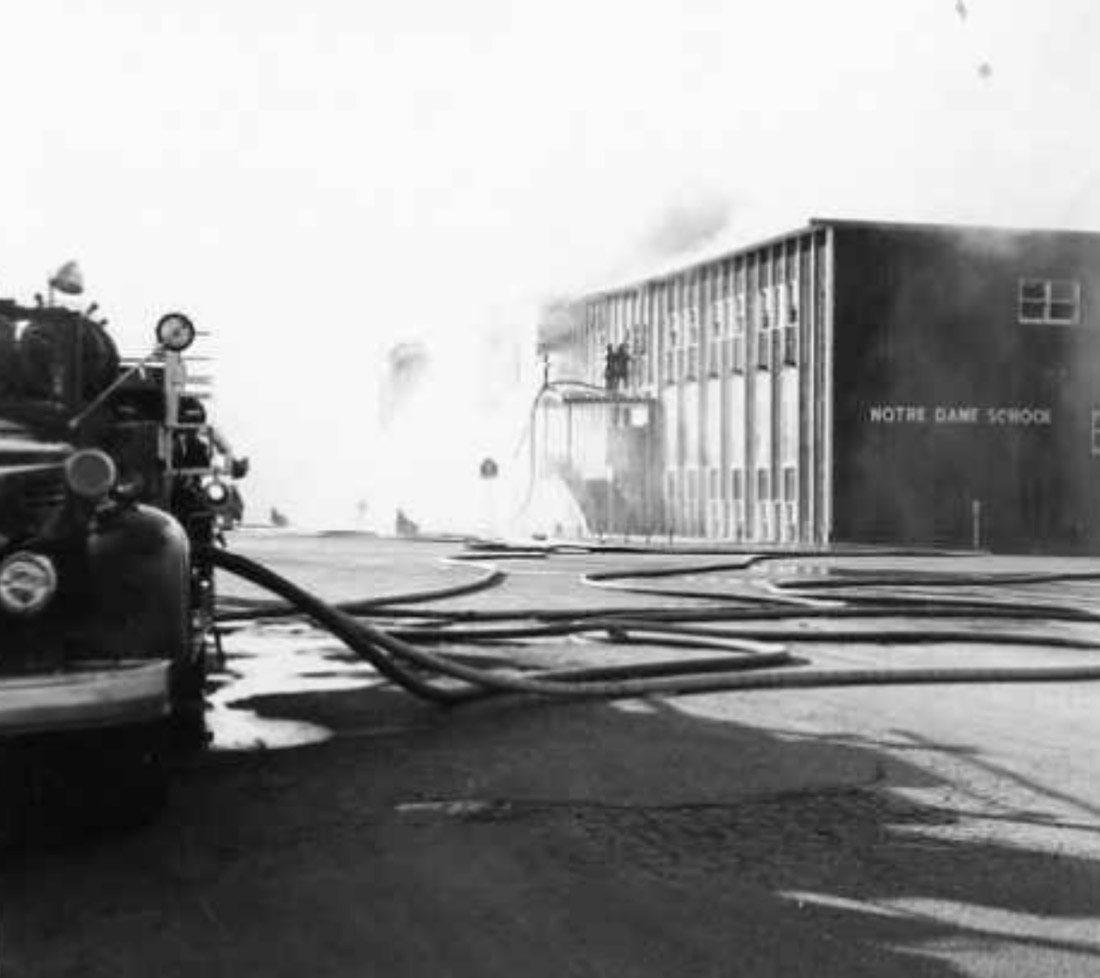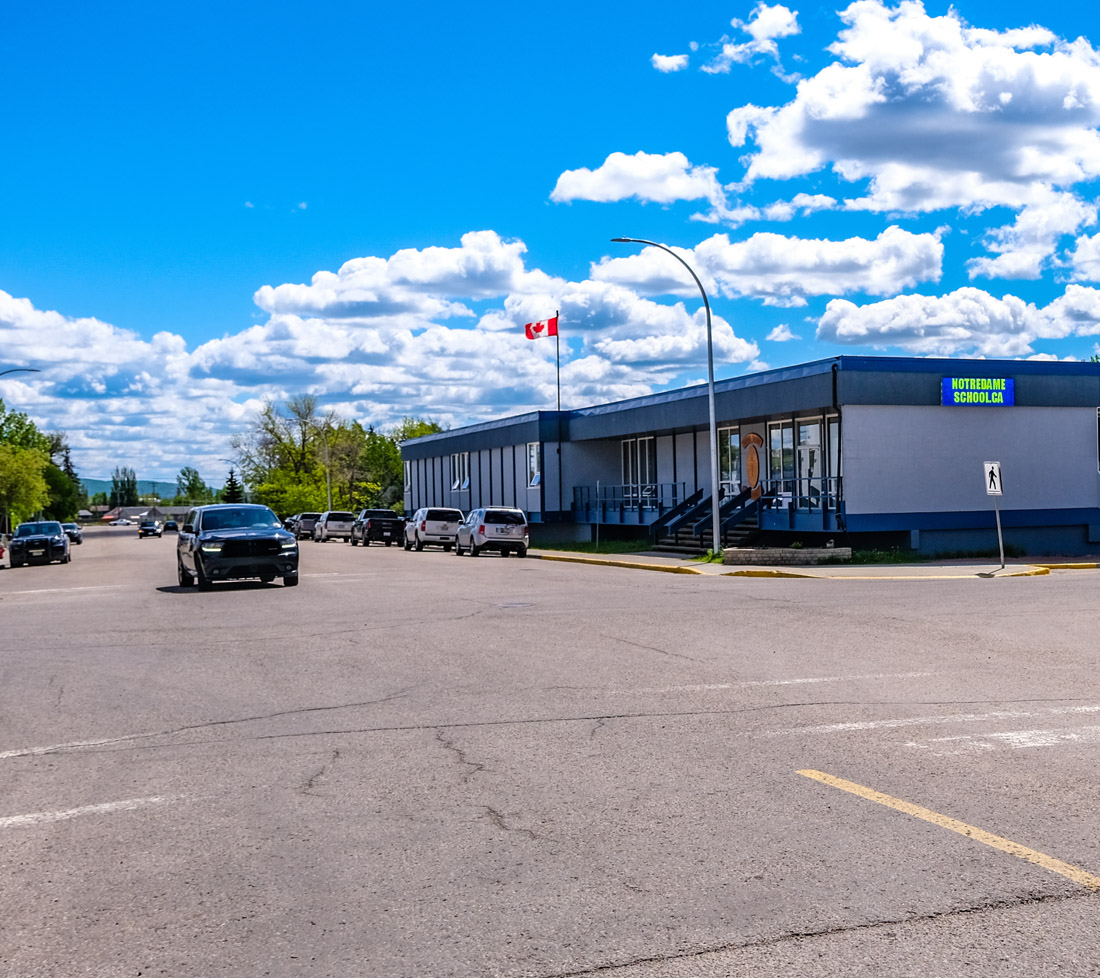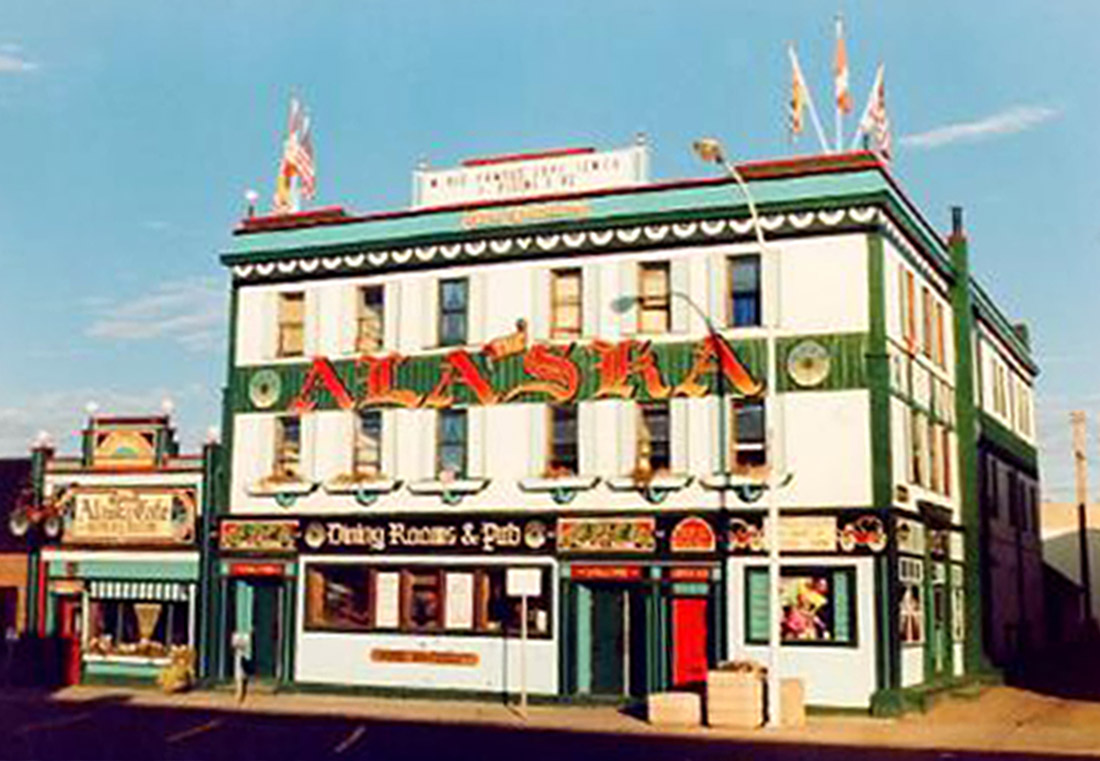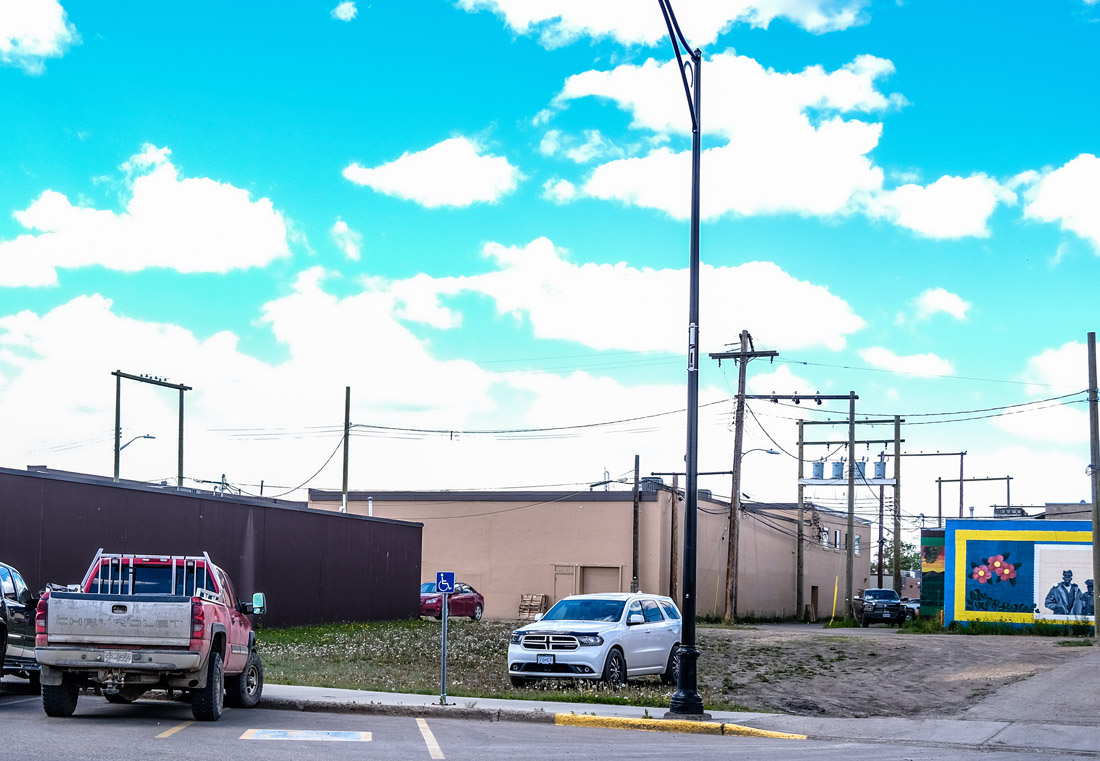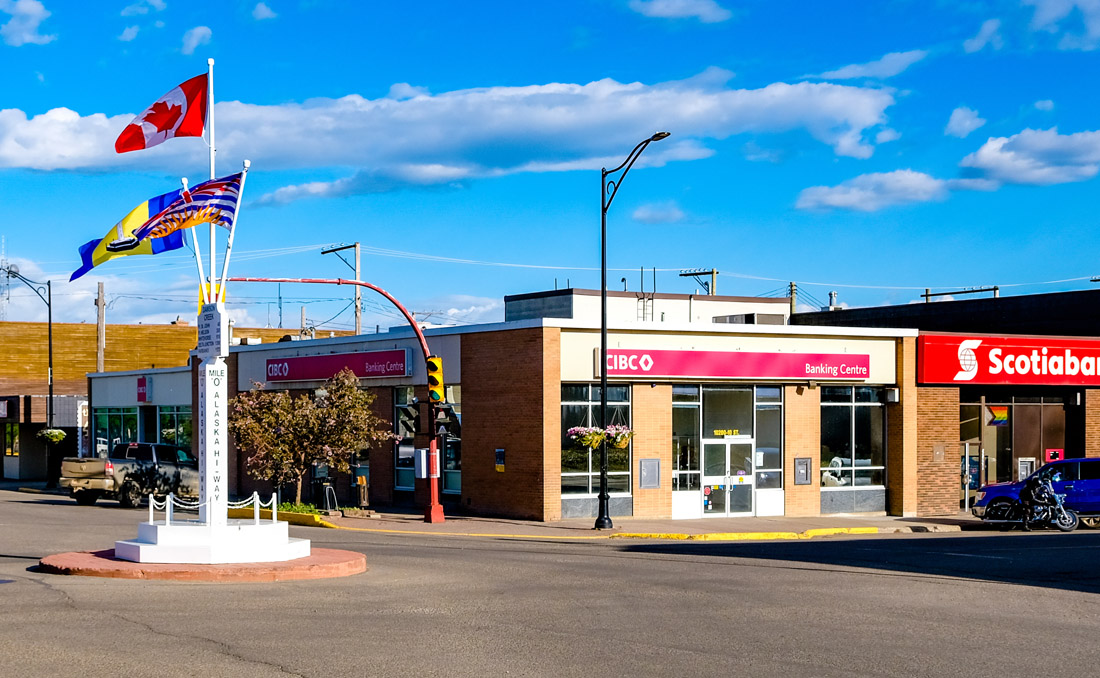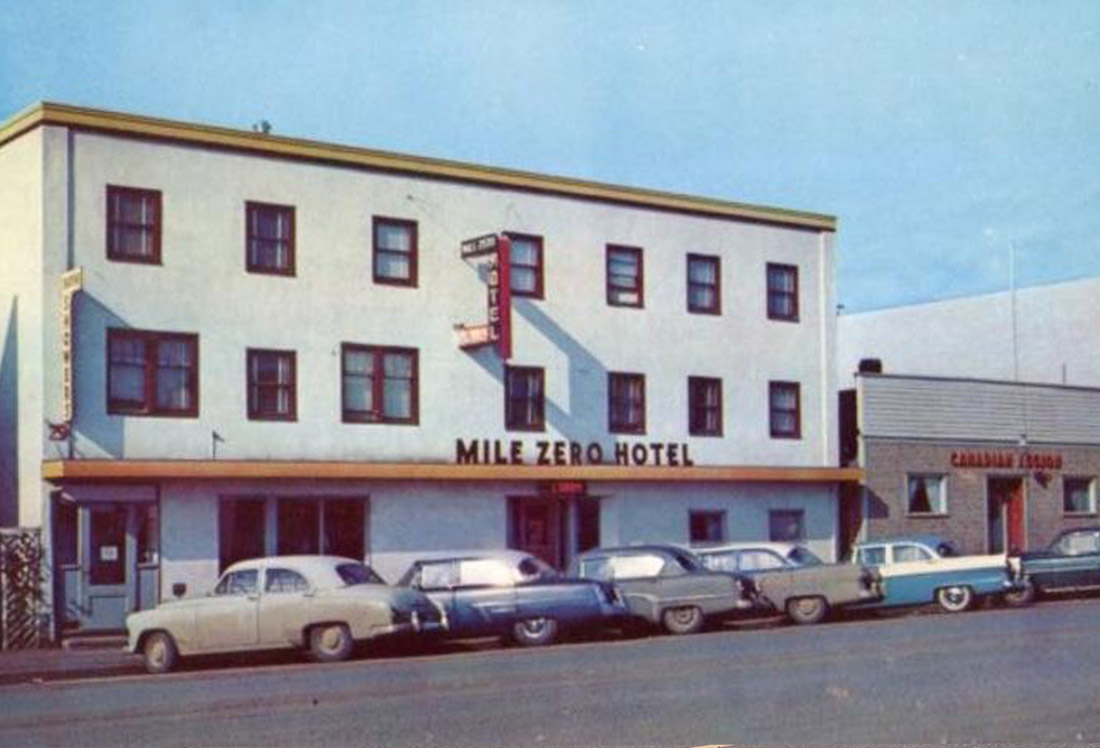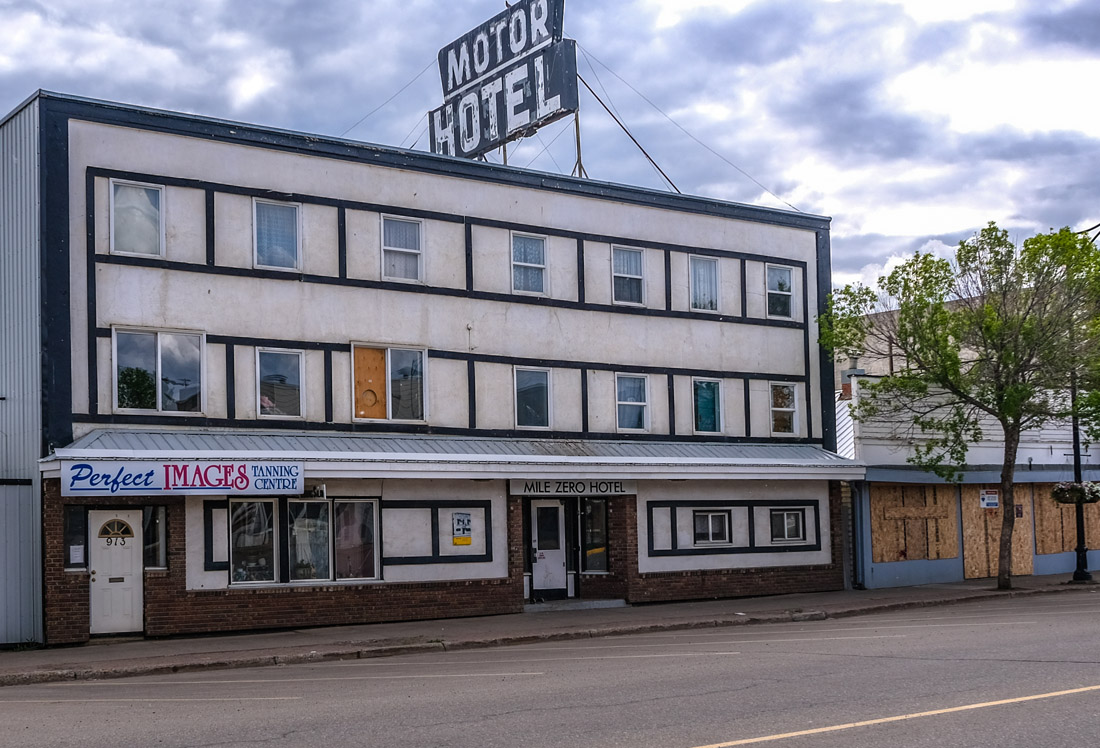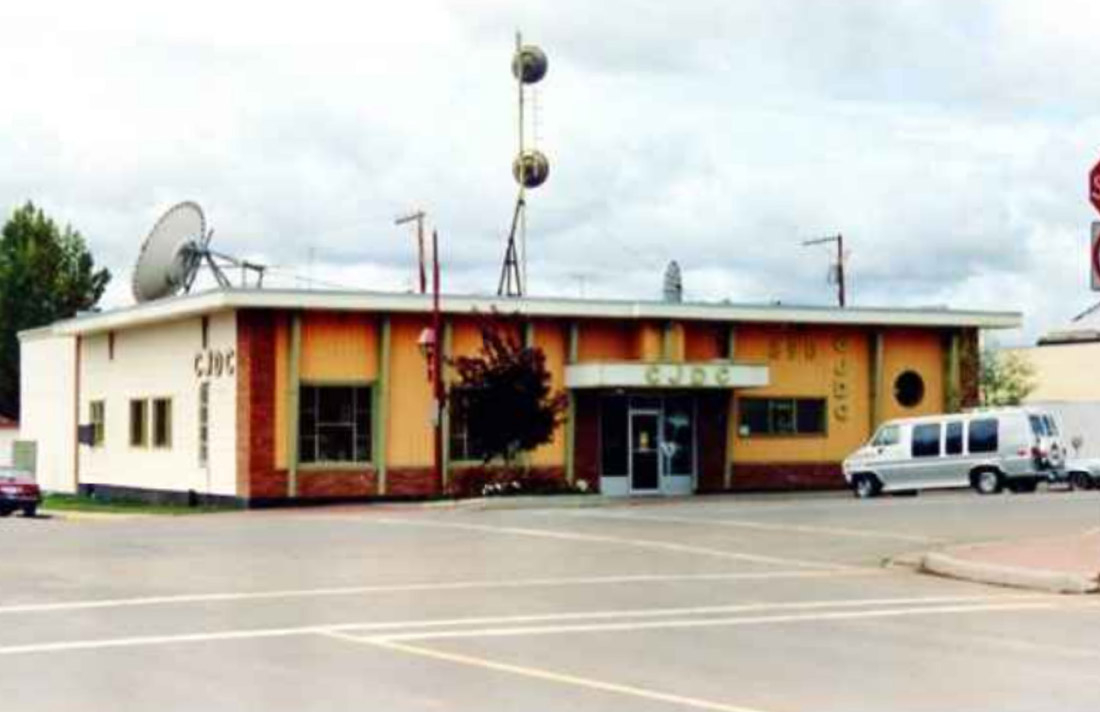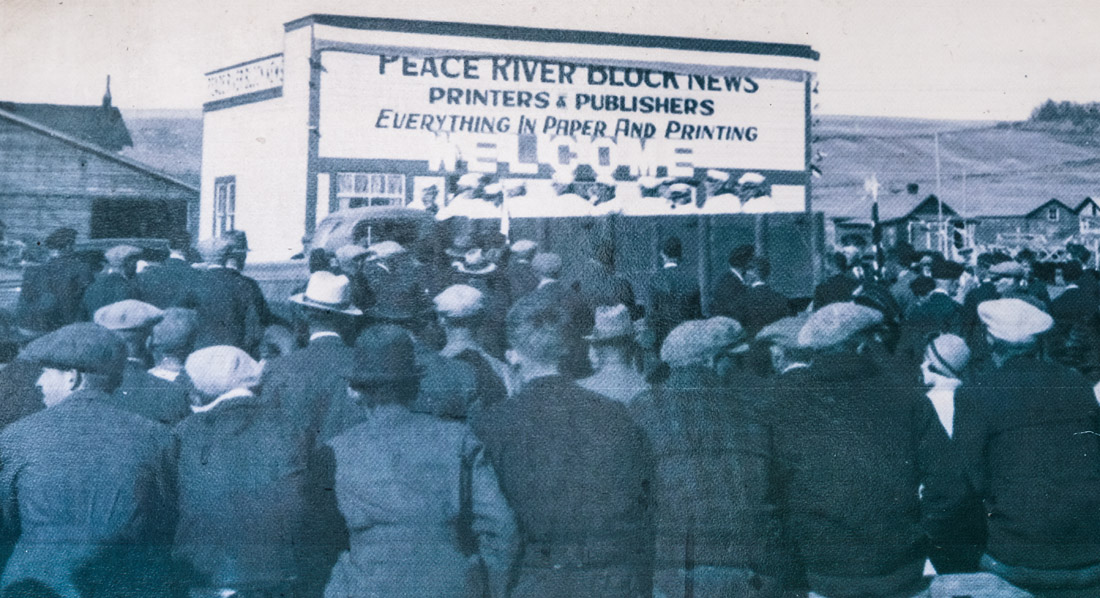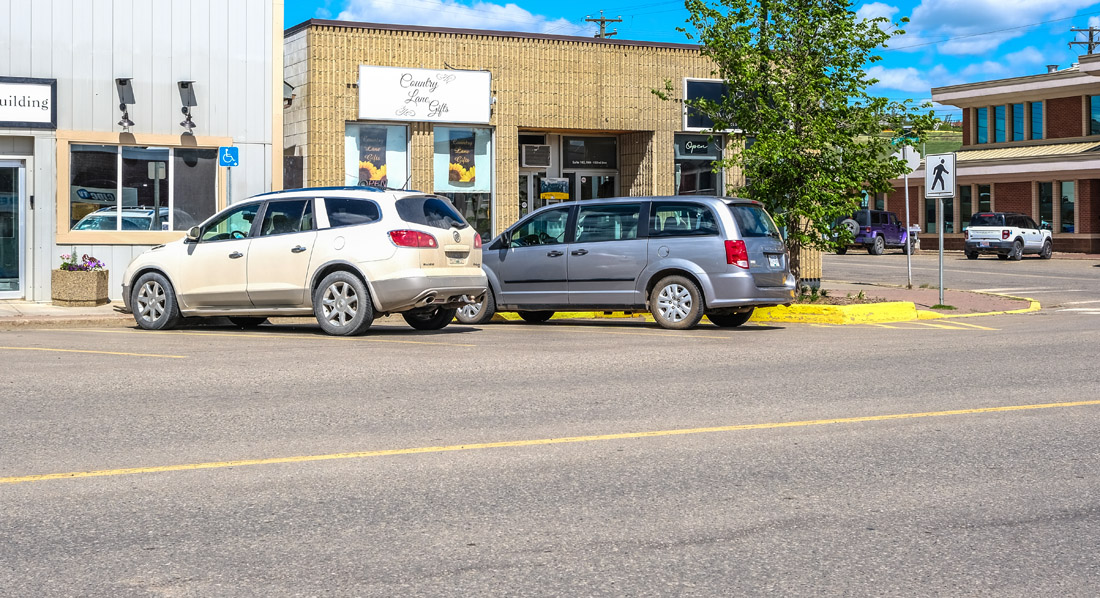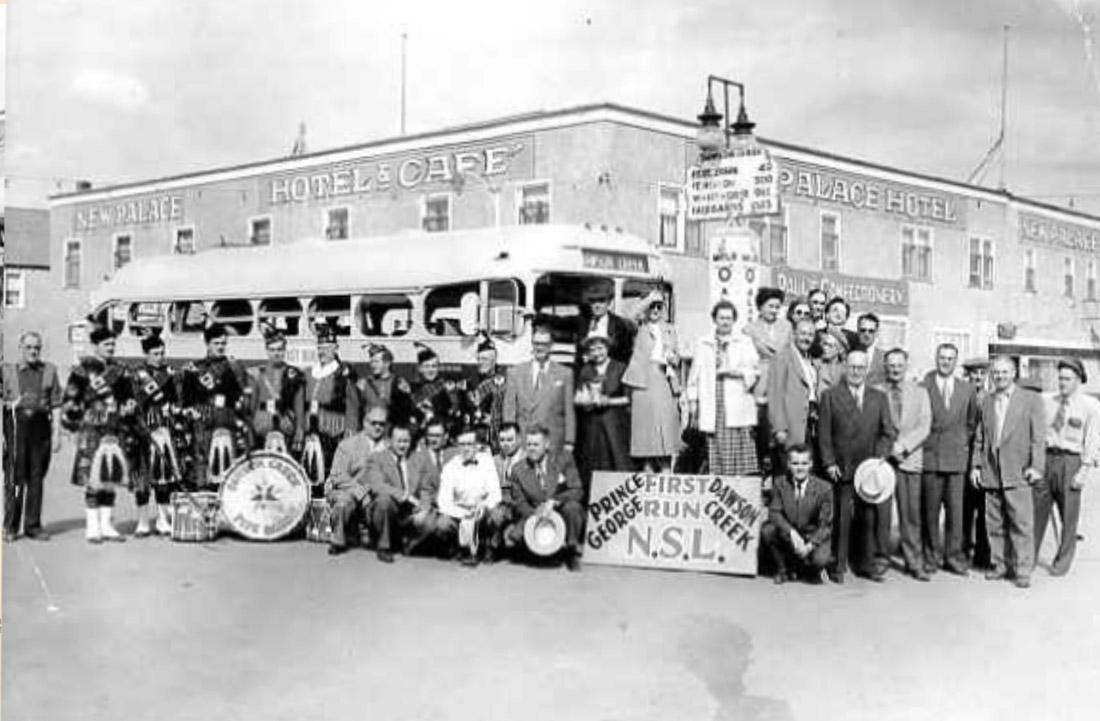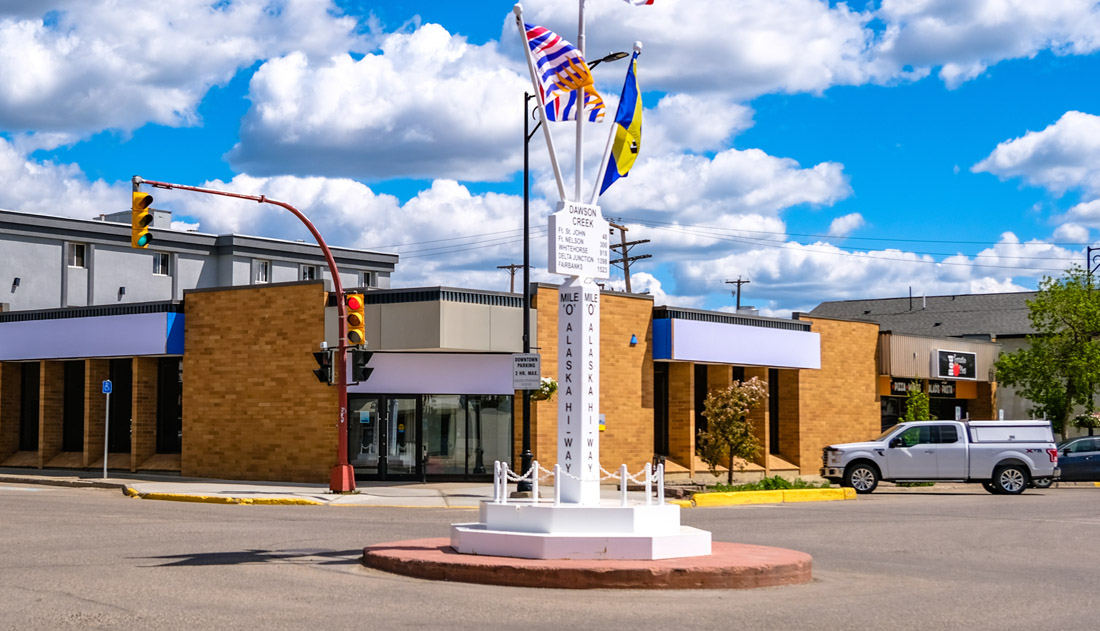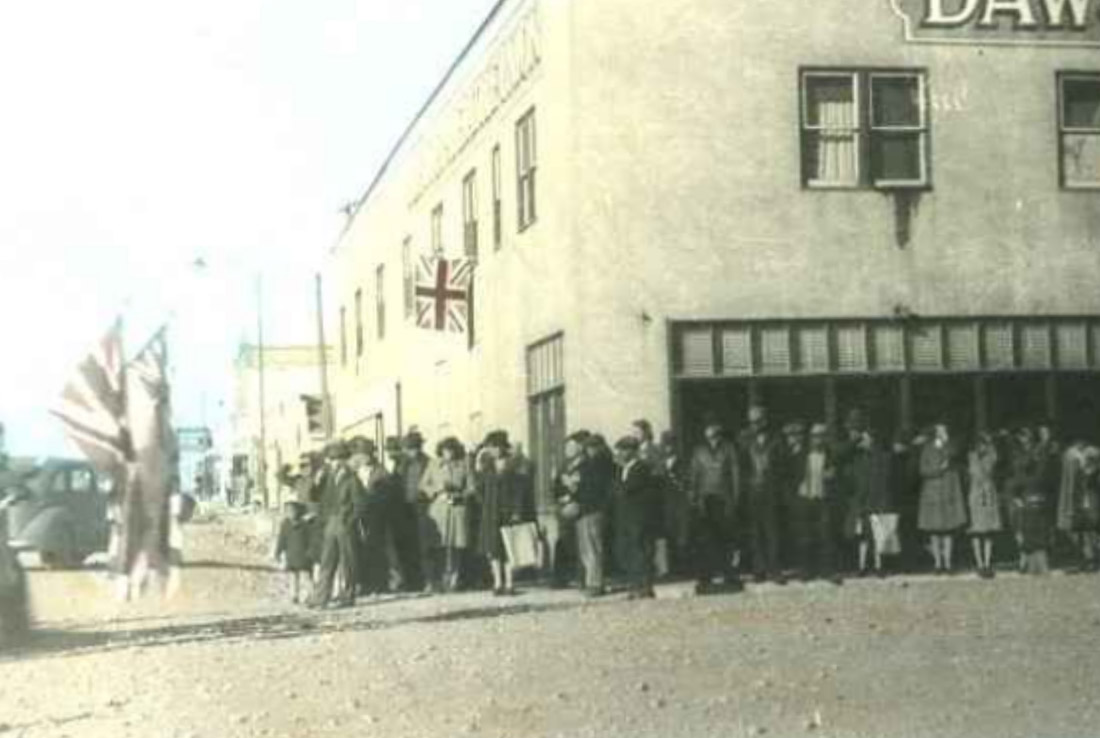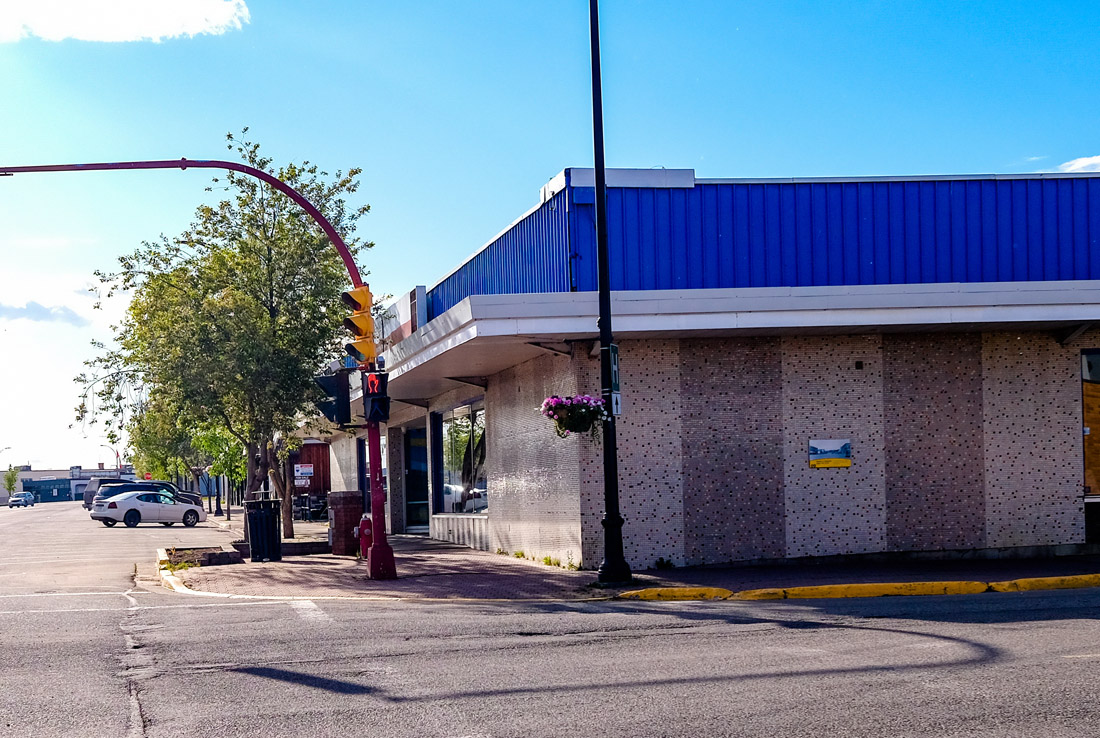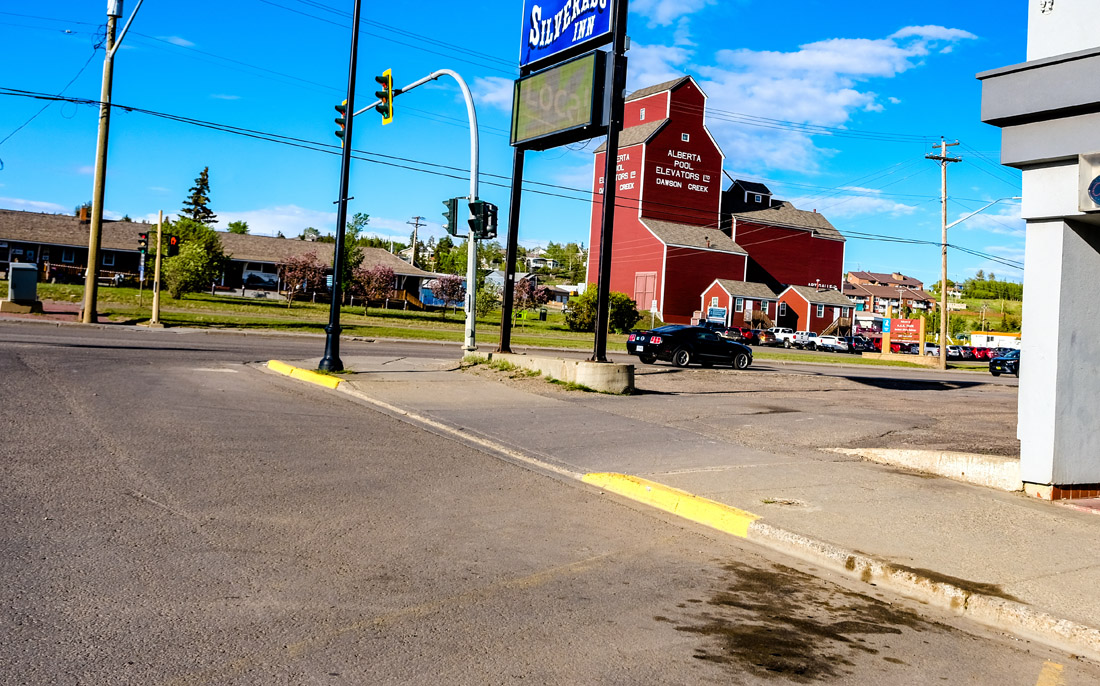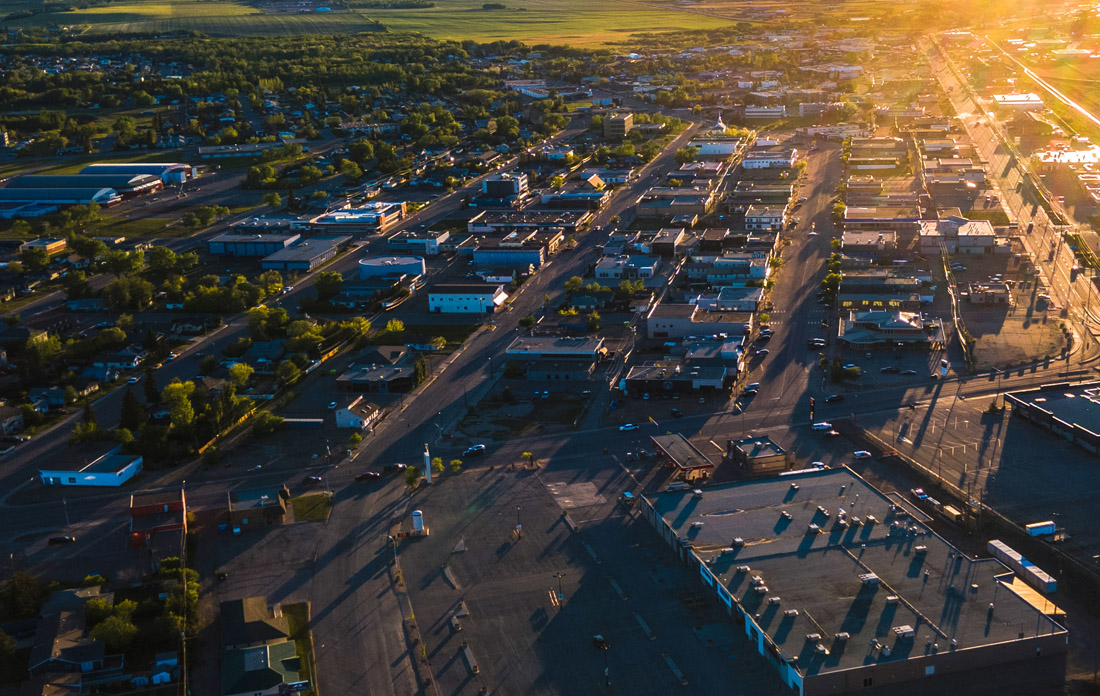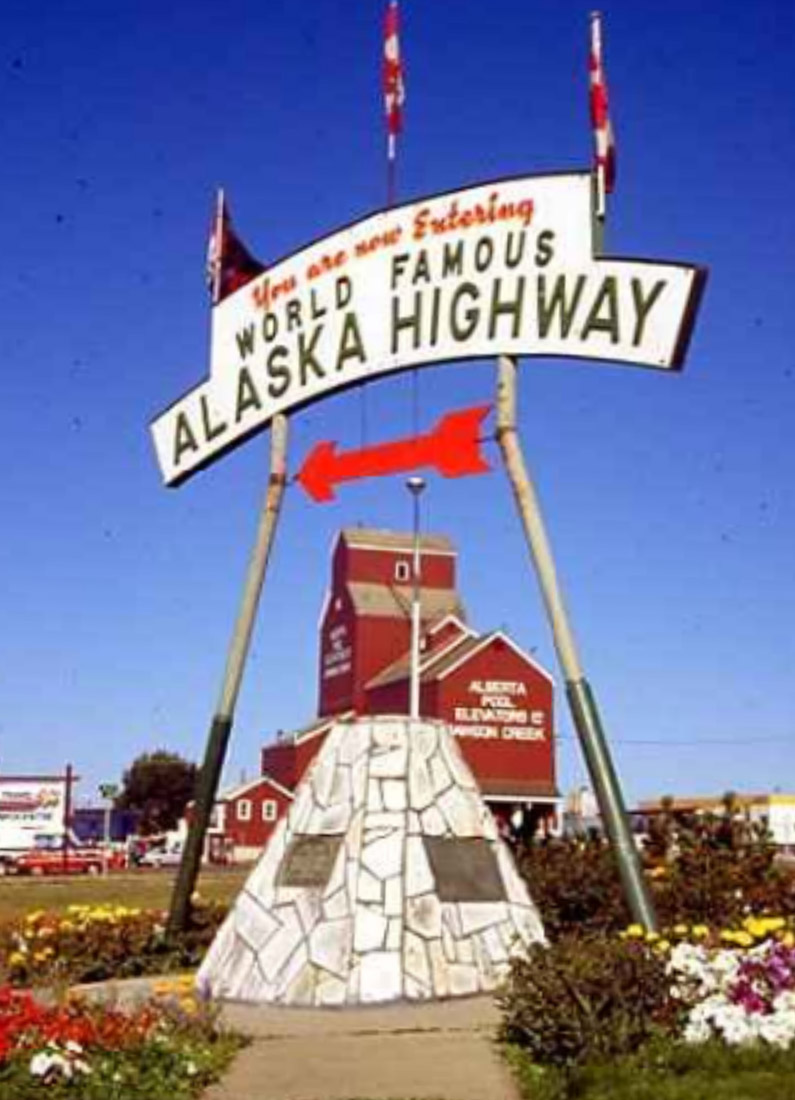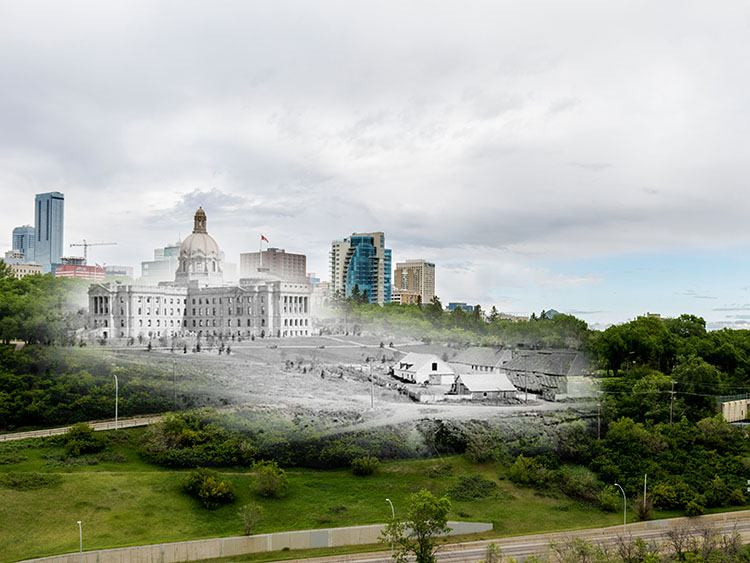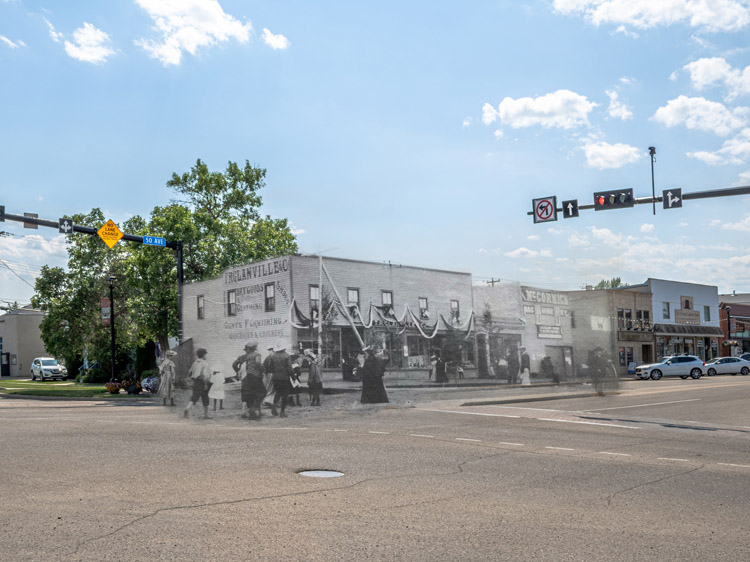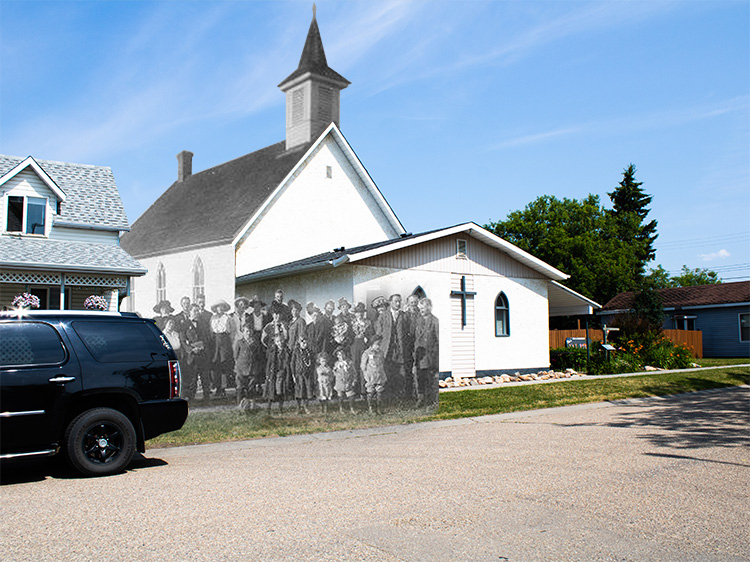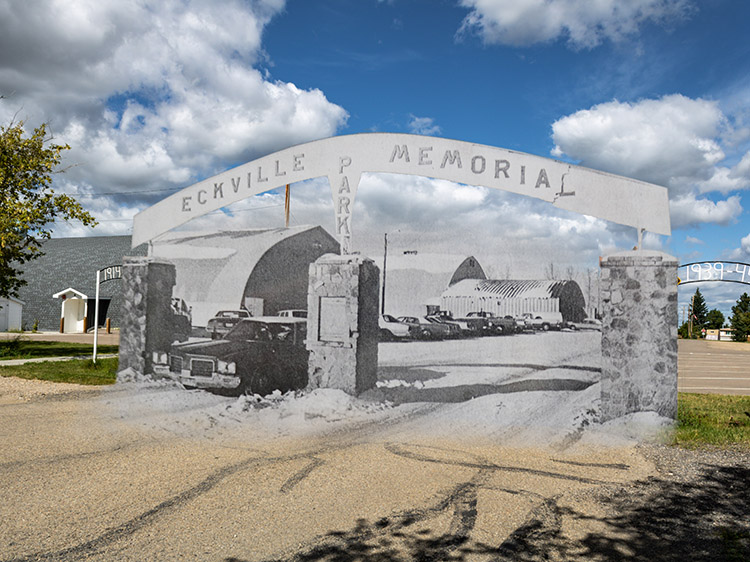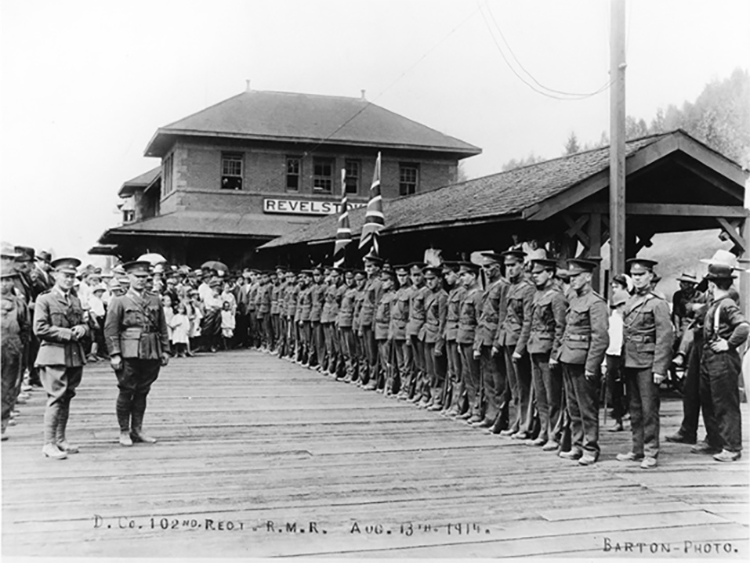Walking Tour
End of Steel to Mile Zero
The Story of Dawson Creek
By Andrew Farris
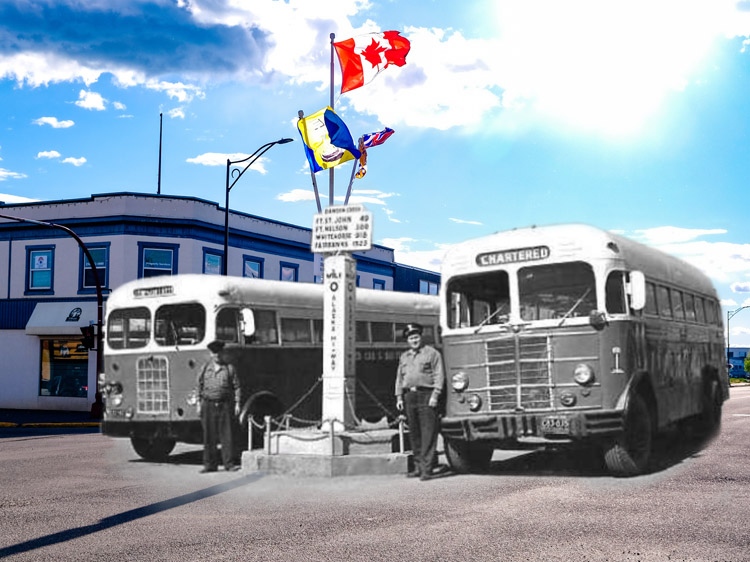
South Peace Historical Society 2021.026.173
Welcome to the "End of Steel to Mile Zero" walking tour of Dawson Creek! As you explore this historic town, you'll uncover the fascinating story of its rapid growth from a railway terminus to Mile Zero of the Alaska Highway. This tour highlights key locations and events, showcasing Dawson Creek's early days, wartime boom, and post-war development. Look for accompanying plaques along the way, providing further insights into the rich history of this unique community.
The City of Dawson Creek acknowledges that we are privileged to live and work on Treaty 8 territory and the traditional home of the Cree, Dane-Zaa, Saulteau, Sikanni and Slavey First Nations. We value the Métis Peoples that live and gather here.
1. Peace Country
South Peace Historical Society 2000.061.010
1949
We begin our tour with this aerial view of Dawson Creek from 1949, and another taken from the same angle today.
Dawson Creek was founded in 1931, which is fairly late as far as Canadian towns go. Yet it grew and matured very quickly. This historic photo was taken less than 20 years later, and we can already see that the downtown had filled out much of the space it occupies today. It has continued to grow and develop since that time, though most of that development has spread out to the suburbs.
* * *
Dawson Creek is at the extreme northwestern corner of the vast prairies that extend across much of Alberta, Saskatchewan, and Manitoba. It is defined by the mighty Peace River, which carves a wide, fertile valley across the region on its journey to the Pacific. Located in the subarctic boreal zone, the climate can be challenging, with long, cold winters and short, warm summers. There is relatively little rain, which promotes the growth of hardy grasses and forests of poplar and spruce.
This region has been inhabited by Indigenous peoples since time immemorial. These include the Dane-zaa, Beaver, and the Cree. According to Dane-zaa oral history the name of the mighty river that defines the region comes from a great peace treaty once agreed between the Cree and Beaver peoples at a place near the confluence of the Peace and Slave Rivers.
The Beaver and Cree developed semi-nomadic lifestyles adapting to the challenging conditions of this region. They hunted game, fished, and gathered plants, and moved seasonally to follow resources. Winter shelters included tipis and lodges, while tools were crafted from natural materials. Their spiritual practices honoured animals and the environment, and knowledge was passed through oral traditions. The Peace River was a key travel and trade route. Starting in the 1700s, European fur traders started to bring changes, and a Metis community came into being. In the late 1800s and early 1900s there was an influx of white settlers, and the Cree and Dane-zaa were dispossessed of their land and confined to reservations. Nevertheless, the Dane-zaa and Cree have continued to preserve their cultural heritage and continue to advocate for the return and protection of their traditional lands.1
2. The Northern Alberta Railway
South Peace Historical Society 2000.035.009
1940
For the first couple decades of the town's history, this railway station was how almost everybody and everything arrived in Dawson Creek. It was the terminus station of the Northern Alberta Railway (N.A.R.). As the end of the railway it was called End of Steel. It was actually the decision to make End of Steel at this spot that led to the establishment of Dawson Creek here, rather than the other way around.
An important aspect of Dawson Creek's history is that the railway came from Edmonton, Alberta, rather than the population centres of southern British Columbia. This meant that Dawson Creek's early cultural and economic development were heavily oriented towards neighbouring Alberta.
* * *
Dawson Creek's being in British Columbia rather than Alberta is a bit of a historical curiosity. The Rocky Mountains form most of the southern border between Alberta and British Columbia. The Rockies were not well mapped north of the 53rd parallel. So in 1863, when colonial administrators wanted to append a huge tract of land to the colony of British Columbia, they just drew a straight line at the 120th meridian north from the 53rd parallel all the way up to the Arctic Circle at the 60th parallel, and put everything west of that line in BC.1
This put the enormous and fertile territory of the Peace Country under the administration of a province that was cut off from it by the Rocky Mountains. No road or rail links to the rest of BC would be completed until after the Second World War. Alberta, on the other hand, was only 15 kilometres east of Dawson Creek and there weren't any mountains in the way.
That meant that everyone who came to Dawson Creek got here via Alberta. Many of those who came to farm the Peace Country or settle in the town were themselves from Alberta. Unsurprisingly, the economy developed along much the same lines as Alberta's own Peace Country. Most cultural influences came from Alberta too: until the late 1940s the only radio station in Dawson Creek was broadcasting from Grand Prairie.
This decision led to a rather strange state of affairs where a region that had so many similarities to the province on the other side of the meridian was governed from Victoria, about 1,000 km to the southwest. It could only be accessed by air or over an extremely circuitous route through Alberta.
3. N.A.R. Park
South Peace Historical Society 2000.051.063
1985
This 1985 photo shows Northern Alberta Railway (N.A.R.) Park, with the Dawson Creek Art Gallery housed in the historic grain elevator. Unlike many agricultural towns on Canada's prairies, Dawson Creek has preserved one of the grain elevators that once dominated the town's skyline. This grain elevator is a fundamental part of Dawson Creek's heritage, and indicates the main driving force behind the early European settlement of this region and Dawson Creek's main economic engine in its early years.
* * *
After the First World War that began to change. The Canadian government encouraged veterans to settle here and begin farming. Many took up the offer and found success growing wheat as well as oats that supported cattle ranching.
The biggest change came when the Northern Alberta Railway opened up access to this region, reaching the new-found community of Dawson Creek in 1931 and providing the Peace Country's first year-round road or rail link with the outside world. Five huge grain elevators like the one you see here were constructed to house the wheat as it waited to be exported by rail.
This coincided with the Great Depression and a historically severe drought across much of the prairies. The Peace Country fared somewhat better and so during the 'dirty 30s' many desperate farmers from Alberta and Saskatchewan relocated to the Peace Country to try their luck.
Agriculture in the Peace Country underwent a massive boom in the 1950s as farmers diversified and increasingly cultivated canola, barley, flax, peas, and honey.
Though the grain elevators are now gone—with the exception of the one converted into an art gallery—agriculture continues to lead this region's economy. There's about 11.5 million acres of farmland in the region, over a quarter of all the farmland in BC. That land supports some 1,500 farms that produce, among other things, over 90% of the province's grain and 95% of its canola.2
4. The Dawson Hotel
South Peace Historical Society 2000.061.029
1936
In this view looking across Alaska Avenue, opposite the N.A.R. Station, we see Dawson Hotel going up. “The Dawson” became a community landmark in those early years, and was one of several hotels that anchored the new community of Dawson Creek.
When the town was established many of its first inhabitants came from a small community now remembered as Old Dawson. In 1931 they had made the bold decision to pack up their whole village—buildings and all—and move to Dawson Creek. These people formed the nucleus of the new town..
* * *
Whichever community was picked as the terminus was sure to become the biggest town in the region. The railway had difficulty getting any local farmers in those communities to sell them an appropriate plot of land for a townsite. Getting frustrated, they decided to talk to Duncan 'Dunc' McKellar, who owned most of the land.. Dorthea Calverley, a historian and chronicler of Dawson Creek's early history, records what happened next:
"One day in early 1930 a railway employee sought out McKellar to drive him over the area. At the end of their tour of inspection he told Dunc, 'You are looking at the future site of the town of Dawson Creek'. Dunc’s land was flat, and large enough for the railway’s purpose. They agreed on a reasonable price.
"Construction began at once on the high wooden trestle across the [Dawson Creek], the subdivision of town lots, the location of a huge water reservoir on the west side of town, the railway station [now a museum], freight sheds, shops and the 'wye' [railway turntable]. Five [grain] elevators were rushed to completion."1
The railway's decision sent reverberations around the region and sealed the fate of the other communities.
"Not only did Rolla and Pouce Coupe see their commercial dreams collapse, but so did the bustling little centre known as Bullenville, a short distance southwest of Dawson Creek. The village was locally known as 'Donation Creek' or 'Moonshine Centre.' The good citizens of that informal village [Bullenville] accepted their lot philosophically, and moved lock, stock and barrel to the new Dawson Creek. Thereafter, the deserted location became known as 'Old Dawson.'"2
Old Dawson is located in what is now a suburb of Dawson Creek, where 108 Ave passes by Newby Park.. Today there is no evidence of the bustling little community that briefly grew up there in the 20s before the move.
5. 10th Street in the 40s
South Peace Historical Society 2000.080.009
1942-3
This photo, taken in 1942 or 43 shows a busy, built-up, and muddy 10th Street. A whole range of businesses have grown up, and the many new-looking parked cars and trucks and fashionably dressed men and women hint at the growing prosperity of the rapidly growing town. As the N.A.R.'s End of Steel, Dawson Creek prospered as the service hub for farmers across the region. An even bigger driver of change came when Dawson Creek was designated Mile Zero of the Alaska Highway during the Second World War.
6. 1940s Street Scene Mural

This mural celebrates the building of the Alaska Highway and the impact the project had on the community of Dawson Creek. Mural shows a typical street scene of that time.
* * *
Dawson Creek continued its slow but steady growth through the rest of the 1930s, a feat more remarkable than it may first appear. These were the Dirty 30s, when the worldwide Great Depression coincided with a brutal years-long drought on Canada's prairies. Most farming towns in Alberta and Saskatchewan stagnated or shrank as 'dust bowl' conditions literally blew away the fertile soils upon which their prosperity depended.
The Peace Country Block, the triangle of arable prairie that extended into BC, had only just opened up for settlement and wasn't as badly affected by the drought. Word spread, and many farmers who had given up on their plots to the east resettled in the Peace Country in search of better fortunes.
Even though Dawson Creek weathered the 1930s relatively well, and could look forward to better years to come, it's unlikely anyone foresaw the colossal changes that would come to Dawson Creek in the aftermath of the Japanese attack on Pearl Harbor. Within a year Dawson Creek would become Mile Zero of a titanic allied effort to protect Alaska by connecting it to the rest of North America.
7. Co-op Fire North
South Peace Historical Society 2022.002.101
1948
Here we see firefighters battling a fire that has engulfed the Dawson Co-op Union. The Co-op store is one of the town's oldest businesses, having been founded at Old Dawson in 1921 and then moved to this spot in the new Dawson Creek townsite ten years later. While the building didn't survive this fire, the Co-op did and eventually moved to a location on the other side of 8th Street, near the Mile Zero roundabout.
Wooden-built frontier towns were acutely vulnerable to the scourge of fire, and Dawson Creek was no exception. This fire in 1948 caused enormous damage, but it hardly compares to the disaster of February 13, 1943, when a truck of TNT exploded and destroyed most of downtown.
* * *
She watched as townsfolk and nearby soldiers went to work dousing the fire in the barn, which was stuffed to the brim with telephone lines, tools, and vehicle parts. Just across the street a standing-room-only train had arrived and disgorged its passengers into the street, who gathered into a gigantic crowd to watch. It was then that the firefighters discovered to their dismay that someone had parked a truck of TNT in the barn.
Watching from a distance, Calverley recalled:
"Suddenly a DIFFERENT flame shot out from the eastern side. It was a swirling cylinder of lurid, coloured flames and indescribable fumes and smoke that ascended at an angle. Then another.
"Next she remembered seeing "the sudden falling down of those nearest the building, followed by a concentric falling of those farther and farther away. Before the sound or blast reached the spectators a block away, they had time to wonder what ailed everybody that they were lying down in circles one after another. Then the blast hit them and over they would go like a bowling pin.
"The burning building and its contents — completely red-hot — went hundreds of feet in the air. Where the brightness of flames had been a second before there was a momentary blackness as the fire was snuffed out like a candle. But a few minutes later there were hundreds of small fires as debris came down over a block away in all directions."
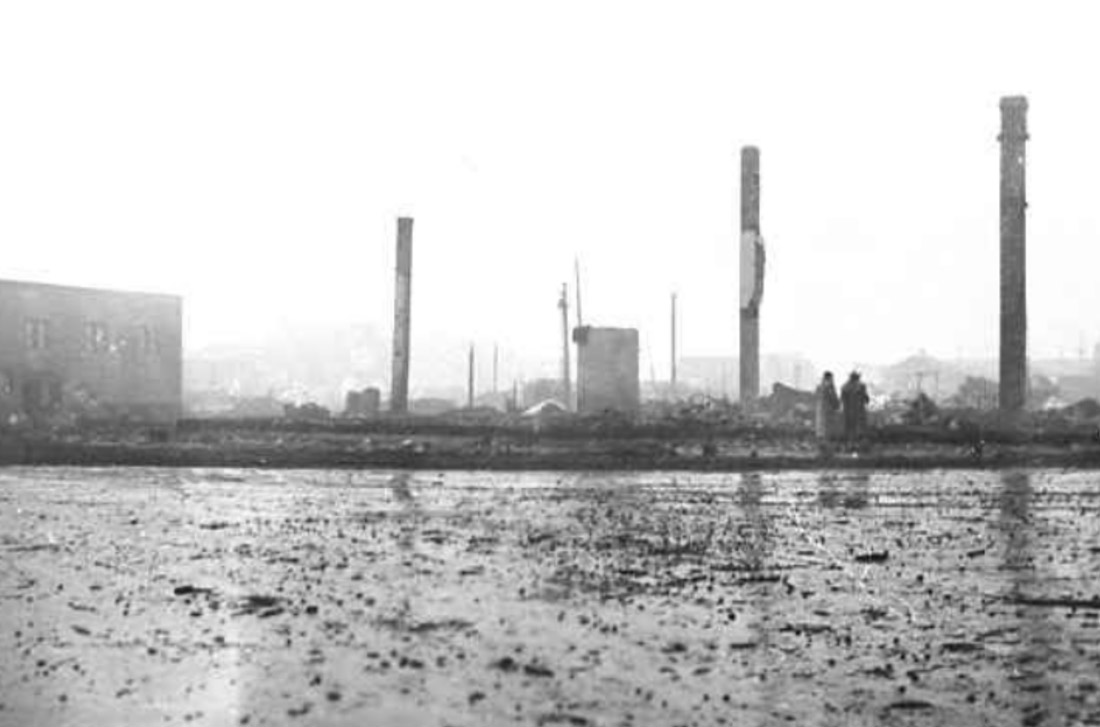
"The only buildings in town that remained without gaping windows, fallen chimneys, crazily twisted doors or smashed-in walls were those isolated buildings of the original village... Northwest of the main intersection, by ten o’clock on that terrible evening, only one wrecked and looted building remained — the old Dawson Co-op Union store. All the rest lay under a smoldering mass of debris where sporadic bursts of flame consumed what little was left of the main business section. Soldiers guarded the ruins of the old village and some looted the wrecks that somehow miraculously escaped the flames."1
In the end five people were killed in the explosion, with a further 164 injured. It was the greatest disaster in the town's history.2
8. People of the Community Mural

This mural showcases a few notable citizens who developed and impacted our community. The paintings are meant to give you insight into the spirit of Dawson Creek.
9. Explosion Block
South Peace Historical Society 2000.050.232
February 1943
North east from the corner of 11th Street and 102nd Avenue. Damage from the explosion was estimated at $350,000 war-time dollars (10 times that amount in today’s dollars).
10. Memory Lane
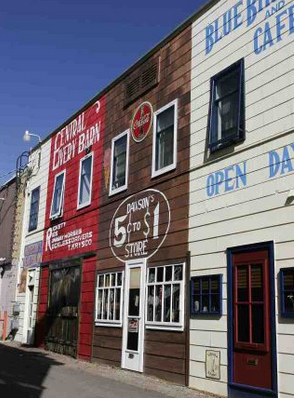
These unique alley murals survived the September 2012 fire that claimed the historic Alaska Hotel. If you look carefully you will notice evidence of the blaze on some of the murals which are paintings of actual buildings as they once were.
11. Kittson Soldiers
South Peace Historical Society 2001.099.003
1943
This photo from early 1943 was taken at the height of the Alaska Highway building boom. As you can see from the blown out windows in the G. Kittson Drug Store, it was taken in the immediate aftermath of the great explosion that destroyed much of downtown. It shows several American soldiers, amongst them two from the black labour battalions that helped build the Alaska Highway. These men were subjected to blatant racial discrimination and kept confined to army camps outside of town until their help was desperately needed in disaster relief efforts. This photo is likely the first time these men were allowed into Dawson Creek itself.1
Standing on this corner today, you can turn to the left and see the Mile Zero marker in the middle of the intersection. While the marker wasn't put there until 1946, it is a permanent reminder of why the soldiers were here.
After Japan attacked Pearl Harbor in 1941, the Americans realized that Alaska was virtually defenseless and easily cut off by sea. They needed a land connection to the far north so they could send troops and supplies to fend off Japanese invasion. As Dawson Creek was the end of the rail way, it was the natural starting point for this highway. Thus it became Mile Zero. In an atmosphere of wartime urgency, a titanic construction effort began and Dawson Creek was at its heart.
* * *
Starting in March 1942, Dawson Creek was overrun by Americans, who set up sprawling tent camps on the eastern side of 8th Street. Some of the Americans deployed were from segregated black units, as we see from the above picture. In just eight months they succeeded in punchinging the highway through five mountain ranges and over innumerable rivers and creeks. Ultimately the project cost $185 million, or what would be $3.4 billion today.2
The historian Dorthea Calverley describes the impact these years had:
"The effect of the influx of American servicemen on the North was in one sense permanent — it sped up the development of these communities by perhaps ten or twenty years. The presence of a large floating population nearly equal in size to that of Victoria or Saskatoon literally forced civilization on the North. It is a maxim of the United States Government that nothing is too good for the American soldier and when he wants something he generally gets it. Thus, roads, hotels, motion picture theatres, stores, hospitals and modern sanitation sprang up almost overnight where the soldiers were stationed.
"The southern base of construction operations on the Highway was Dawson Creek… With 518 inhabitants at the 1941 census, Dawson Creek had a resident population of 5,000 at the height of the boom. Thousands of American soldiers, truckers and construction workmen were located along the Highway between this village and White Horse. The influx of population severely taxed the water supply and showed the inadequacy of the sanitation system. Water was accordingly brought in from the Cut Bank River, twelve miles away, and modern sanitation methods were adopted."3
The highway was taken over by the Canadian Government in 1946. Today over 300,000 people visit it every year, starting in Dawson Creek and ending in Delta Junction, Alaska, via Whitehorse in the Yukon.
You can learn much more about the Alaska Highway in On This Spot's accompanying audio tour.
12. The Mile 0 Post
South Peace Historical Society 2001.027.008
1947
The Mile 0 Post the year after its unveiling on Christmas Day 1946.
13. The Butcher Block
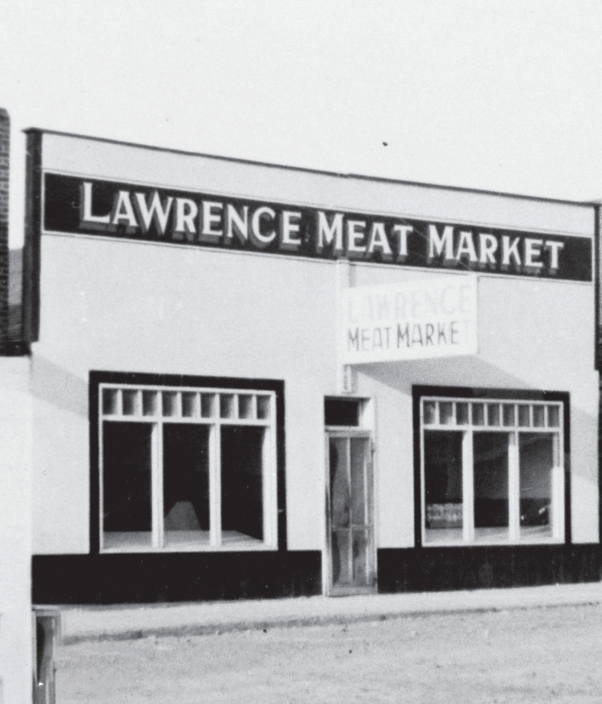
South Peace Historical Society
This original building had its windows blown out and its refrigerated showcases blown up in the 1943 explosion. In 1976 it was torn down, rebuilt, expanded in size and given a name change.
14. The Post-war Boom
South Peace Historical Society 2000.072.056
1961
People line 102 Ave to watch a parade pass by the Toronto Dominion Bank building, which today has expanded to encompass a larger section of the block. For the young town of Dawson Creek, the late 1950s and early 1960s were a remarkable period of rapid population growth, economic prosperity, and widespread optimism.
* * *
15. Windsor Hotel
South Peace Historical Society 2000.011.009 Series 04
This is where the Windsor Hotel once stood. Built in 1951 at an eye-popping cost of $250,000 (nearly $3 million today), the Windsor came to represent Dawson Creek's postwar prosperity. It advertised itself as the "Northland's Finest Accommodation."1
This was the age of mass car tourism, and this image is from a postcard which would have been sold to those first car-borne tourists. The Windsor was a popular spot for them to get a good night's sleep in a comfy bed before beginning their long journey along the Alaska Highway.
* * *
In keeping with the times it had two beer parlours—one for men and another for ladies and their escorts. In the 1950s a single room would go for $2.50 a night ($30 today) and a double for $6 ($70 today).
The Windsor fell on hard times and by the 2000s it was in a state of disrepair. After property taxes went unpaid, the City of Dawson Creek took over the hotel but failed to find a new buyer. In 2005 the hotel was demolished, an event that many people turned out to witness.2
16. Carlsonia Theatre
South Peace Historical Society 2000.051.064
1940
In 1951 the theatre was demolished. The lot sat empty until Aspol Ford Motors bought it in the early 1960’s, sold it to the Windsor Hotel for parking, and bought it back a few years later.
17. The Police Station
South Peace Historical Society 2001.095.043 Series 01
1945
The police station was located in the building you see in this historic photo, on the corner of 10th Street. Dawson Creek had a small police force at the time this photo was taken. In 1948, a Royal Canadian Mounted Police detachment took over policing and moved into a new station, at the Joe Dill location. Later on, in 1961, the RCMP along with the fire department, moved into the city hall block just a few blocks to the west off Alaska Avenue.
* * *
During the war the US Army was on hand to provide more advanced fire equipment, though it was of fairly limited utility when most of the town blew up in February 1943. After the war Dawson Creek's fire brigade continued acquiring increasingly sophisticated and modern equipment, and today the fire department is equipped to handle whatever conflagrations may arise.1
18. Department Stores
South Peace Historical Society 2000.011.010 Series 04
1959
A Woolworth's Department Store once stood here, built just after the Second World War. Just the next block over the Hudson's Bay Company also opened a large department store around the same time. These were another indication of the growing prosperity of Dawson Creek in the post-war boom years.
* * *
19. Harper's General Store

South Peace Historical Society
The second Harper’s General Store was in business until 1952 when it was sold to the Hudson’s Bay Company.
20. Hudson's Bay Store
South Peace Historical Society 2000.061.019
1957-65
The Hudson’s Bay Company bought the Harper’s General Store of the 1940s and rebuilt it. The store was a downtown mainstay for years before changing to Zeller’s in the early 1990’s. The building has since been remodeled and is home to several unique Dawson Creek businesses.
21. The Catholic Church
South Peace Historical Society 2000.035.002
This was the Our Lady of Perpetual Help, the first catholic church in Dawson Creek built in 1931. It was demolished in 1965 and the congregation moved to the Notre Dame Parish church just half a block to the west on 104 Ave.
* * *
Once Dawson Creek became established a range of beliefs came to town, though the great majority of them were ChristianIn the 2021census only about a third of the 12,000 strong population identified as Christian. The largest self-identified denomination was catholic, with more than 1,500 adherents. While many christians didn't indicate their denomination, amongst those who did the largest were United (350), Lutheran (280), Anglican (255), Pentecostal (180), and Baptist (105). Though not as many people actively identify as religious, there has been a growth in religious diversity in recent years. There are now populations of practicing Sikhs, Hindus, Buddhists, Muslims, and Jews.1
22. Calvin Kruk Centre for the Arts
South Peace Historical Society 2000.072.091
1965
Looking back across the intersection we see what was once the federal government's administrative building in Dawson Creek. Today it is the Calvin Kruk Centre for the Arts, named for Dawson Creek's community-minded mayor from 2005 to 2008.
* * *
The facility boasts a variety of dance studios, theatres, and an auditorium, and is your best bet for all the latest cultural exhibitions and performances right in the heart of Dawson Creek.
23. Notre Dame Quarter
South Peace Historical Society 2000.051.409
1968
In 1968, the Notre Dame School went up in flames. As you can see, it then rose from the ashes.. Founded as a catholic school during the Second World War, the Notre Dame school has been a key educational institution in the heart of Dawson Creek ever since.
* * *
In 1945 the school rapidly expanded to 130 students from grades 1 to 8, including 50 students who lived there as boarders. There was so much demand for education in Dawson Creek that the Sisters added grades 9 to 12 and even opened the Notre Dame Business College.
The barracks were always meant to be temporary structures, and so in 1952 the school was moved to a new purpose-built building—the one you see burning here. Through the 1960s the Sisters and the Notre Dame Parish struggled to finance the school. Finally they agreed to give the school to the parish so that they could build a long-desired church.
A history of the school explains what happened next: "Hardly had the pastor announced these glad tidings to his flock on Easter Sunday, 1968 when in the silence of early dawn, Notre Dame School went up in flames. The Alma Mater which had been the joy and pride of its old students was no more."
While the school was temporarily relocated back into the old barracks after the 1968, the school building you see today was constructed shortly after using insurance money from the fire.
"And so, on the ashes of old Notre Dame and its hosts of memories, a beautiful new school proudly stands — an edifice worthy of the sacrifices of so many of Mother Gamelin’s valiant missionaries who toiled that others might reap so rich a harvest."1
24. Joe Dill's Funeral Home
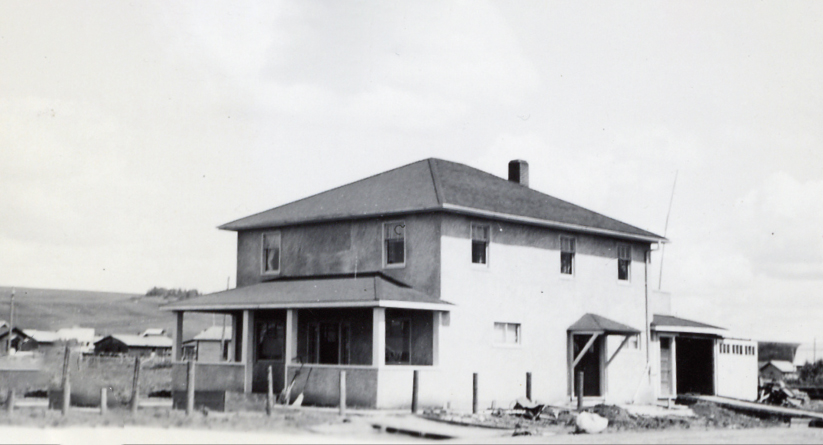
South Peace Historical Society
ca. 1940s
1958 saw the Royal Bank commence business in Dawson Creek. After two temporary sites, the bank chose this site for its permanent home, which had previously been Joe Dill’s Funeral Home.
25. Bill's News
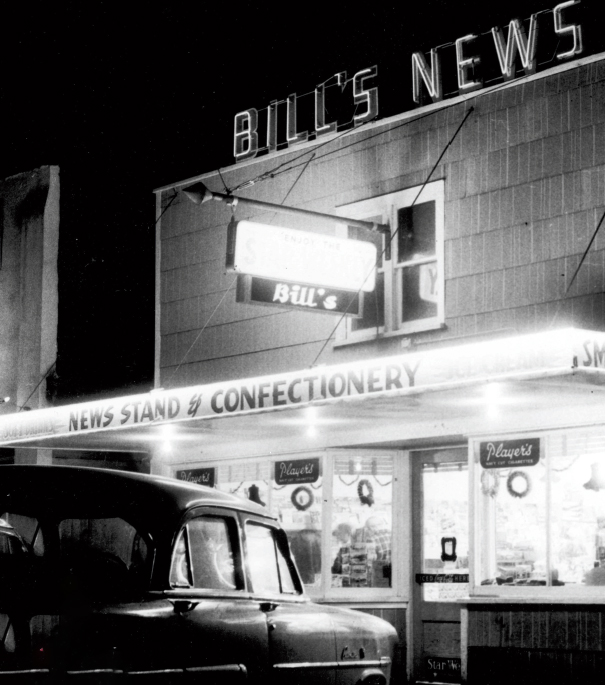
South Peace Historical Society
Built in 1949, Bill’s News had low ceilings, wooden floors that always creaked, and friendly staff. The Bill’s News of today was built circa 1970
26. The Alaska Hotel
South Peace Historical Society 2022.002.503
1992
This playfully colourful building was the Alaska Hotel, the most recognizable and best known landmark in Dawson Creek. The hotel was first built in 1931 and known as the Dew Drop Inn. With the arrival of American troops to build the Alaska Highway during the Second World War, the hotel was greatly expanded and given its famous name. It was the only pub in town, and as such became the chief social hub in Dawson Creek for American soldiers stationed here.
* * *
Sadly, in 2012 the hotel caught fire and burned to the ground. Mike Bernier, mayor at the time, told the CBC that as word spread about the fire, it seemed as if everyone in Dawson Creek came out to watch and mourn the loss.
"When I was walking around through the crowd last night, people were quite teary, people were hugging each other… It was quite emotional especially people who have been in the community for a couple of decades who could really appreciate the historical value of this building… [It's] basically known worldwide as an iconic landmark commemorating the northern part of British Columbia and the Alaska Highway… It is just an incredible loss."2
27. Bank of Commerce
South Peace Historical Society 2000.070.001
1944
In 2004, the Canadian Imperial Bank of Commerce (CIBC) celebrated 75 years of doing business in Dawson Creek. The building has seen many changes, but the bank remains on its original lot. In the 1940’s, it was the only financial institution on the Alaska Highway.
28. Trail of 42 Mural
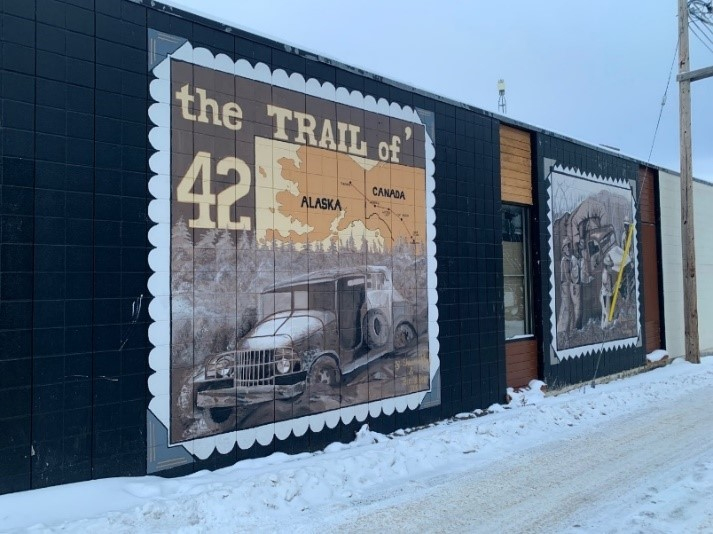
These panels depict scenes of the formidable terrain the men endured and the machinery used for construction of the Alaska Highway in 1942.
29. Mile 0 Hotel
South Peace Historical Society 2000.061.021
1964
This is one of the oldest hotels in Dawson Creek. Its first name was The Red Apple. Over the years, this hotel has had many other names: Maple Leaf, Shangri-La, Spanish Grill and then in 1945, the Blue Bird Hotel & Café.
30. Tuning In to CJDC
South Peace Historical Society 2001.101.271 Series 07
Here is Dawson Creek's iconic radio station CJDC, which can be found on your dial at 890 AM. CJDC has been keeping the people of the Peace River Country informed and entertained ever since it first began transmitting in December 1947. The new radio station was greatly welcomed by the town's residents since up to that point the only signal they could get was a faltering and staticky broadcast from Grand Prairie's CFGP—some 110 km distant.
* * *
"It had been a long, hard, painful birth, but it had taken place. The youngster was born live and healthy and was well received, too. And, although there were setbacks of one kind or another in the first few months, these were strictly internal, and were eventually resolved. The station went on to success.
"A Radio Drama Group was formed and read 'productions' with varying success, but great enthusiasm. Public Forums discussed the issues of the day. Local people commented on local topics and pursuits, local artists performed. Somehow the announcers seemed to read more fluently. In a day when hitherto unheard of foreign names popped into every newscast, somehow the broadcasters seemed to be able to cope with them.
"At that time we were the farthest north radio station in the British Empire. Dawson Creek had come of age – it had its own radio station. At that time Dawson Creek was only a village of approximately 3,300 people. No wonder everyone was proud of it."1
31. Army Headquarters
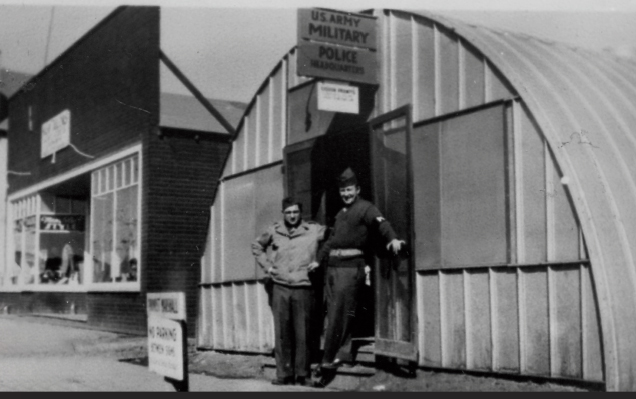
South Peace Historical Society
1942
In 1942, Next to the site of the original Peace River Block News, the army set up a Quonset hut for its military headquarters. The hut was used for war-time housing of troops and equipment.
32. Peace River Block News
South Peace Historical Society 2000.051.049
1939
A crowd gathers outside the offices of the Peace River Block News in the mid-1930s. The Peace River Block News went by several names over the course of its life, and served as the paper of record for the Peace Country from the founding of Dawson Creek in 1931 to the paper's closure in October 2023.
* * *
By 1970 the News boasted a circulation of 5,300 and a staff of 22. In the 1970s the Kitchen family sold the paper to new owners, who brought it under the control of Conrad Black's newspaper empire. The paper began to be published bi-weekly and then daily.
In 2006 the paper was sold to Glacier Media, who renamed it the Dawson Creek Daily News.1
Glacier Media, which had bought up many local papers across the province, struggled to cope with the rise of the internet and subsequent collapse in revenues from print advertising. In a bid to cut costs they amalgamated the Daily News with another one of their other properties, Fort St. John's Alaska Highway News. The Alaska Highway News would now serve as the paper of record for BC's Peace Country. They also spun off a weekly edition aimed just at Dawson Creek called the Dawson Creek Mirror.
Despite successive and ever deepening cuts to staff and services, Glacier Media failed to turn the ship around. In 2023 they pulled the plug on the entire operation and permanently shuttered their newsrooms in the Peace region. The Alaska Highway News and the Dawson Creek Mirror published their final editions on October 13, 2023, ending a 93-year story that traced the entire history of Dawson Creek.
"I'm sorry this company could not keep your paper going," wrote The Mirror's managing editor Rob Brown wrote in a farewell letter.2
The closure of these papers, along with the independent Fort Nelson News around the same time, has left the entire Peace Region without a newspaper.
33. Connecting BC
South Peace Historical Society 2000.051.170
1953
Returning to the town's central intersection of 10th Street and 102nd Ave, we see a beaming group of men and women as well as a pipe band, a Northern Stage Lines bus, and the iconic Mile Zero marker. These are the staff of the Northern Stage Lines company and they are celebrating the inauguration of their bus service to Prince George.
* * *
This state of affairs finally came to an end in 1952, when the 405 kilometre long John Hart Highway was completed. It was named for British Columbia's Second World War-era premier who championed its construction. The Alaska Highway project, recent discoveries of oil and gas, and the enormous hydroelectric potential of the Peace River had finally drawn the attention of the provincial government in Victoria. They were finally moving to integrate the Peace Country with the rest of the province.
The John Hart Highway connected Dawson Creek and its surrounding Peace River Country with Prince George, and from there the province's population centres far to the south and west.
An accompanying rail link to the rest of the province would take even longer. The Pacific Great Eastern Railway, which also ran to Prince George, would finally reach Dawson Creek in 1958. High voltage transmission lines, and oil and gas pipelines would soon follow. The Peace was finally becoming a part of British Columbia.
34. Bank of Montreal
South Peace Historical Society 2021.026.173
1947
Since 1930 this site has seen many changes: from a small general store, to a large general store, to a large hotel and cafe, to an empty lot, to the present day Bank of Montreal.
35. RCAF Parade
South Peace Historical Society 2001.015.011
1944
A crowd of onlookers has gathered in front of the Dawson Creek Co-op to watch a detachment of Royal Canadian Air Force service members parade down the town's main street during the Second World War. Notice the Union Jacks and Royal Canadian Air Force (RCAF) flags at the left of the historic photo.
* * *
As the terminus of the 2,300 km Alaska Highway, Dawson's Creek airstrip would be used to ferry in and out high priority construction supplies and VIPs. It was also a link in the chain of airfields that composed the Northwest Staging Route. This scheme allowed lend-lease supplied fighters and bombers to be flown straight from American factories to the Soviet Union, crossing Canada, Alaska, and the Bering Sea along the way.
The airfield was operated by the RCAF until it was shut down at the end of the war. The base was briefly reopened from 1956 to 1964 as part of the Mid Canada Line, a Cold War-era chain of radar stations to provide early warning of incoming Soviet bombers.1
Dawson Creek's civilian airport was opened in 1958 at a new location, to the southeast of the town, where it continues to operate to this day.
36. Silverado Inn
South Peace Historical Society 2000.051.091
1941-2
This corner lot was occupied by DawsonCreek Motors, the Empress Hotel and a small café. All of this space would eventually become the Park Hotel in the 1960’s. Currently it is operating as the Silverado Inn.
37. Harnessing New Energies
South Peace Historical Society 2000.041.156
ca. 1950
Returning to N.A.R. Park, we are just about to wrap up this tour. Along the way we have learned about the many different people, ideas, and technologies that have shaped Dawson Creek. There is one major development over the last 50 years that we haven't yet mentioned: oil and gas.
* * *
Alberta developed their gas deposits quickly, and in 1950 an Alberta company started to pipe natural gas to Dawson Creek for domestic use. This made it the first town in British Columbia to get a gas hookup. Engineers had only recently figured out how to harness this powerful new fossil fuel for domestic use, and people didn't know much about it.
So the turning on of the gas in Dawson Creek was met with much fanfare. This included an impressive gas flare at the Mile Zero Post, a heavy promotional campaign for gas appliances, and "free lessons to housewives wanting to cook with gas but unsure how the new fuel would behave."1
The search for oil and gas fields in the Peace Country continued until finally, in 1951, a Pacific Petroleum well struck oil. It, however, was located up highway in Fort St. John.. Fort St. John wasa much smaller community, and it was only connected to the outside world via the Alaska Highway during the Second World War. The discovery of nearby oil and gas fields slingshotted its growth ahead of Dawson Creek, and it became the heart of British Columbia's oil and gas industry.
Using North-West Tel phone books, Gerald Clare, president of the South Peace Historical Society, found an interesting way to track Fort St. John's rapid relative growth. He noted that in the 1957 phone books, "while Dawson Creek had fairly modern phone numbers like Sterling 2-3938 the numbers in Fort St. John were likely to be just something like “218”. Dawson Creek was by far the larger and more important town in the Peace at the time."
"In that year the phone books for "Dawson Creek and Fort St. John listed about 25 companies in the Oil and Oilfield Service categories for each community…. Six years later, Dawson Creek showed a small decline in numbers while Fort St. John was home to about 65 such companies. The movement of the oil companies to the fields north of the Peace River was well underway and continued for the following 40 years."2
Since 1960, Dawson Creek has continued to grow and prosper with the expansion of the Montney play and liquified natural gas (LNG). However the runaway success of the fossil fuel industry has driven even more rapid growth in Fort St. John, whereas Dawson Creek’s economy is diversified between LNG, agriculture, timber harvesting, cattle, and wind energy.
38. Exploring Dawson Creek
South Peace Historical Society 2003.001.T090
We conclude this tour of Dawson Creek at the Mile 0 Cairn that welcomes visitors to Dawson Creek and to the World Famous Alaska Highway. We hope you enjoyed the tour and learned much about this city's unique history.
If you are energized to dig deeper into Dawson Creek's history you can check out the Walter Wright Pioneer Village, located just 2.5 kilometres north on the Alaska Highway. You can see it on the left.
We also strongly encourage you to listen to our audio driving tour, which accompanies you on a drive through the region's attractions. It also covers the first section of the Alaska Highway as far as beautiful Kiskatinaw Provincial Park and the historic trestle bridge built there in 1942.
Endnotes
1. Peace Country
1. "The Peace River," *Tracking Change.* University of Alberta. https://trackingchange.ca/river-basins/mackenzie/peace-river/
2. The Northern Alberta Railway
1. "THE STATUTES THE UNITED KINGDOM of GREAT BRITAIN AND IRELAND, 26 & 27 VICTORIA, 1863," (London: Eyre and Spottiswoode, 1863), 358. https://www.solon.org/Constitutions/Canada/English/PreConfederation/bcbga_1863.html
3. N.A.R. Park
1. A. A. Guitard, "08-003: Agriculture in the Peace – Past, Present, and Future," *South Peace Historical Society*, (1965). https://calverley.ca/article/08-003-agriculture-in-the-peace-past-present-and-future/
2. Peace River Regional District, "Regional Agricultural Plan: Background Report," (Don Cameron Associates, 2014), 8-9. https://peaceriverfarmandranchbc.com/about-the-peace-river-region/
4. The Dawson Hotel
1. Dorthea Calverley, "03-006: The Choice of Terminal for the National Alberta Railway," *South Peace Historical Archives* (1983). https://calverley.ca/article/03-006-the-choice-of-terminal-for-the-national-alberta-railway/
2. Dorthea Calverley, "03-006: The Choice of Terminal for the National Alberta Railway," *South Peace Historical Archives* (1983). https://calverley.ca/article/03-006-the-choice-of-terminal-for-the-national-alberta-railway/
5. 10th Street in the 40s
1. Harry Giles, "05-001: The Dawson Creek Story", *South Peace Historical Archives* (1959). https://calverley.ca/article/05-001-the-dawson-creek-story/
7. Co-op Fire North
1. Dorthea Calverley, "05-024: The Dawson Creek Disaster: February 13, 1943", *South Peace Historical Archives*. https://calverley.ca/article/05-024-the-dawson-creek-disaster-february-13-1943/
2. "News Archives: Black History Month: The Alaska Highway", *Northwest Polytechnic*, Feb. 17, 2022.
https://www.nwpolytech.ca/news/display.html?ID=2105
11. Kittson Soldiers
1. "News Archives: Black History Month: The Alaska Highway", *Northwest Polytechnic*, Feb. 17, 2022.
https://www.nwpolytech.ca/news/display.html?ID=2105
2. C.W. Gilchrist, "Alaska Highway," *The Canadian Encyclopedia*, (2013). https://www.thecanadianencyclopedia.ca/en/article/alaska-highway
3. Dorthea Calverley, "03-015: The Alaska Military Highway", *South Peace Historical Society*. https://calverley.ca/article/03-015-the-alaska-military-highway/
14. The Post-war Boom
1 *Dawson Creek: Heart of a Rich New Empire,* Dawson Creek Chamber of Commerce, (1957), 1.
2. "Workforce and Population," City of Dawson Creek. https://www.dawsoncreek.ca/en/business-development/workforce-and-population.aspx
3. *Dawson Creek: Heart of a Rich New Empire,* Dawson Creek Chamber of Commerce, (1957), 8.
4. *Dawson Creek: Heart of a Rich New Empire,* Dawson Creek Chamber of Commerce, (1957), 20.
15. Windsor Hotel
1. "Windsor Hotel, Dawson Creek," *ExploreNorth*. https://www.explorenorth.com/library/roads/images-lodges/dawson_creek-windsor_hotel-19571120-%20FairbanksDaily_News-Miner.jpg
2. "The Cost of Building a Hotel in 1951," Tourism dawson Creek Blog, (Sept. 21, 2010). http://mydawsoncreek.blogspot.com/2010/09/cost-of-building-hotel-in-1951-windsor.html
21. The Catholic Church
1. "Census Profile 2021: Dawson Creek," Statistics Canada (2021). https://www12.statcan.gc.ca/census-recensement/2021/dp-pd/prof/details/page.cfm?Lang=E&SearchText=Dawson%20Creek&DGUIDlist=2021A00055955014&GENDERlist=1,2,3&STATISTIClist=1&HEADERlist=0#Note162
23. Notre Dame Quarter
1. "10-030: Notre Dame School, Dawson Creek," South Peace Historical Society. https://calverley.ca/article/10-030-notre-dame-school-dawson-creek/
26. The Alaska Hotel
1. "Farewell to the Alaska Hotel," *Town Spirit*, Sept. 23, 2012. https://townspirit.wordpress.com/2012/09/23/farewell-to-the-alaska-hotel-2/
2. "Dawson Creek's historic Alaska Hotel destroyed by fire," *CBC News*, Sept. 15, 2012. https://www.cbc.ca/news/canada/british-columbia/dawson-creek-s-historic-alaska-hotel-destroyed-by-fire-1.1136698
30. Tuning In to CJDC
1. Gordon Cummings, "05-017: The Birth of Radio Station CJDC," *Sout Peace Historical Society.* https://calverley.ca/article/05-017-the-birth-of-radio-station-cjdc/
32. Peace River Block News
1. "About Us," *Dawson Creek Daily News*. https://web.archive.org/web/20120413043023/http://www.dawsoncreekdailynews.ca/section/dawsoncreek%26template%3Dabout
2. "Northeastern B.C. cities lose their last newspapers," *CBC News*, Oct. 13, 2023. https://www.cbc.ca/news/canada/british-columbia/newspapers-fort-st-john-dawson-creek-fort-nelson-1.6996249
35. RCAF Parade
1. "RCAF Station Dawson Creek," *RCAF Info*. https://rcaf.info/rcaf-stations/british-columbia-rcaf-stations/rcaf-station-dawson-creek/
37. Harnessing New Energies
1. Gerald Clare, "12-020: History of the Oil & Gas Industry in the South Peace," *South Peace Historical Society,* 2003. https://calverley.ca/article/12-020-history-of-the-oil-gas-industry-in-the-south-peace/
2. Gerald Clare, "12-020: History of the Oil & Gas Industry in the South Peace," *South Peace Historical Society,* 2003. https://calverley.ca/article/12-020-history-of-the-oil-gas-industry-in-the-south-peace/





